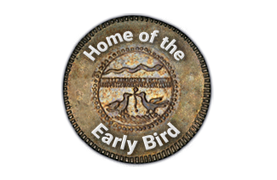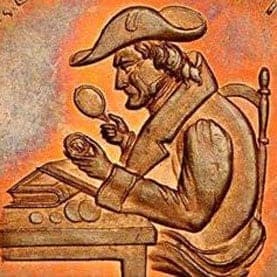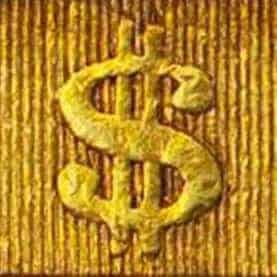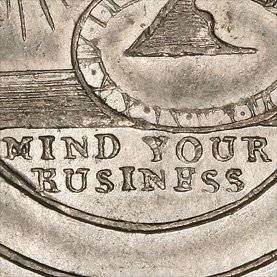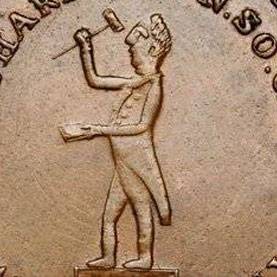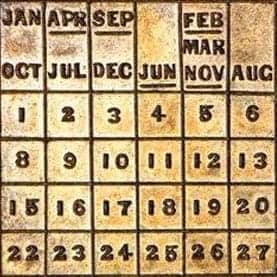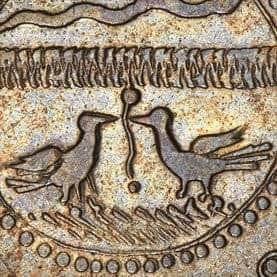May 17, 2014: CRO’s View of the Eric Newman Collection, Part IV
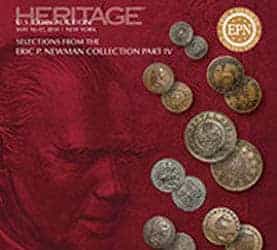
We recently had the distinct pleasure of attending the sale of the Eric Newman Collection, Part IV (the colonials!), in New York. It was an unexpected pleasure too, since I had heard about this collection for years (and years and years), but never thought it would come to market.
But there it was freshly graded by NGC, cataloged by Heritage and sold in a crisp 2-session, 1-day live event in NYC, followed by an internet session the following day.
But my preparation for this mega-event would begin weeks earlier, first by scouring the catalog and studying the coins, then painstakingly researching all of them looking for earlier pedigrees which I hoped to find in auctions from the late 19th and early 20th centuries. Of which I found some, though not nearly as many as I expected.
And then flying to Dallas to view the coins a week in advance in an unhurried, uncrowded setting. So I booked my flight, planned to arrive in Dallas at around 10:30 AM, view for 4 or 5 hours, stay the night and fly back home in the AM. Which would have worked great if not for the severe weather in Dallas that day which first diverted my flight to Shreveport for three hours, finally arriving in Dallas just in time for a tornado warning. Did you know that if you are viewing lots at Heritage’s offices and there is a tornado warning, they have to put the lots back in the vault? I didn’t either. But at the end of the day and despite the delays I got 3 solid hours of viewing in and accomplished most of what I had hoped to do there.
So when I went to NY on Thursday the 15th, it was to re-look, confirm my previous views, make sure I didn’t miss anything and finalize the specific coins I would be bidding on. Which I did over a solid 7 or 8 hours in a room that was waaaay less crowded than I expected. Seriously, where was everyone? I guess they either viewed these coins at a different time, or a whole lot of people would be making their bidding decisions based on the images. Which I do not recommend in general, and specifically not in this case, since these were complicated coins with a lot to take in, with a variety of looks and levels of originality ranging from ‘stone cold’ to ‘not so much’. And plenty with lacquer, or verdigris or spots or other issues to be weighed, evaluated and discounted (at least by me). So by the time I had finished viewing, I was exhausted, but ready.
And then it was show time, as I strolled into the auction room in the Fletcher-Sinclair Mansion on 79th street early enough to get a good seat in the back with a table and electrical outlet access. Which I did, next to my friends and fellow dealers Tony Terranova and John Kraljevich, where we would go head to head on many lots while still remaining friends (I think) which is one of the cool things about this business.
Starting with lot #30001 and the Virginia coinage, including a nice group of Halfpennies which I would characterize as mostly fresh and attractive and graded by NGC about as I expected. Prices were about as I expected too, which is to say that there did not seem to be any real ‘Newman Premium’ associated with these coins.
The first ‘big’ coin in the session would be lot #30014, the 1774 Virginia Shilling graded AU58 by NGC, one of just 5 known, 2 of which are impounded in the Smithsonian and the museum at Colonial Williamsburg respectively. And so if you want one of these, your chances are very, very limited, which is why I expected a wicked strong result. Didn’t happen though, with this piece bringing a seemingly very reasonable $94,000 (this and all images in this article courtesy of Heritage):
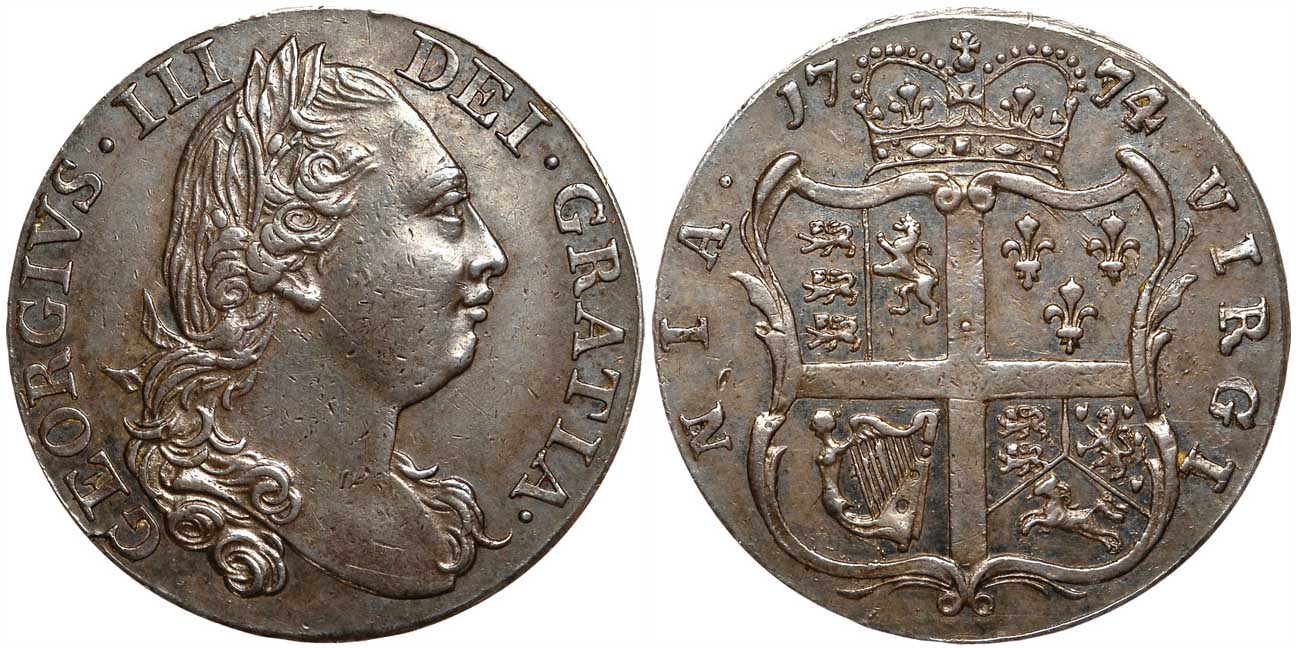
And then we were on to the Vermont coins, including a group of Landscape coppers ranging from extremely ordinary to absolutely killer.
The former included lot #30017, a dark rough, environmentally damaged and verdigrised example of a 1785 VERMONTS Ryder-2 in an NGC XF Details holder which realized $822.50:
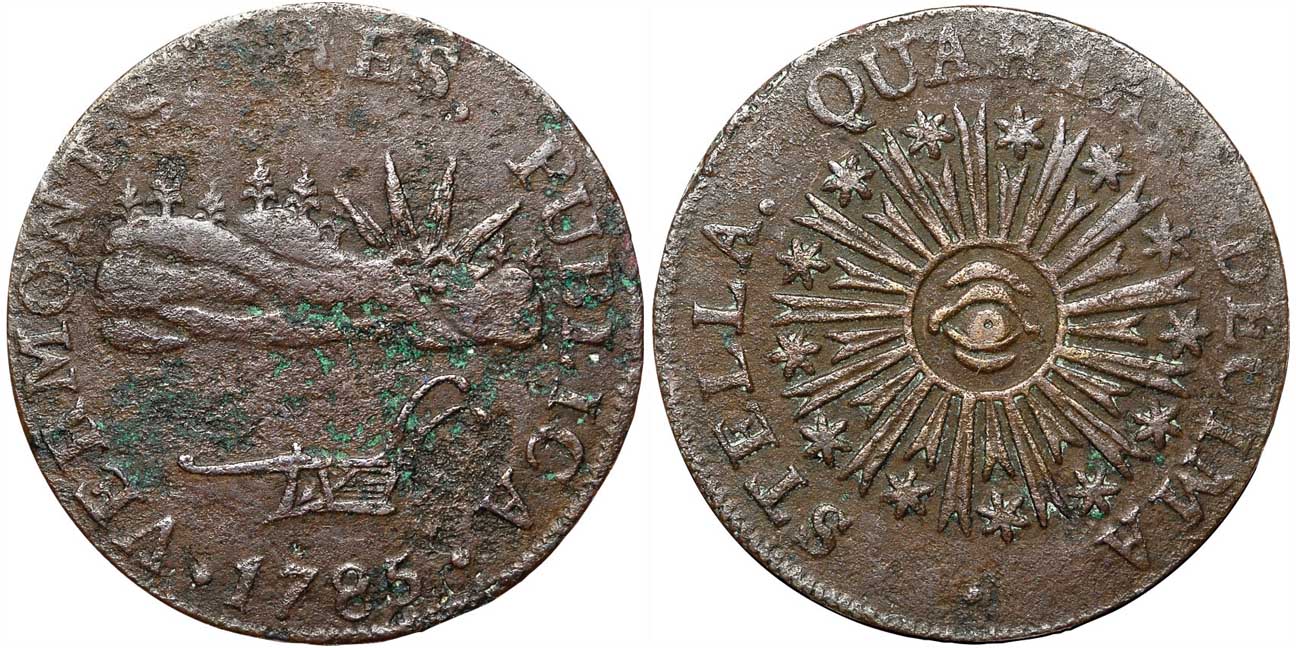
The latter including lot #30024, the first of two deluxe VERMONTENSIUM varieties, this a Ryder-6 graded AU58 by NGC. I thought this was one of the most aesthetic examples of this extremely popular type I’ve ever seen or know about, with a lovely planchet, superb color and excellent centering for an issue that doesn’t often (or ever) come this way. Which explains why this was one of the few coins in the sale I knew I would not be leaving without, and I didn’t, buying it for $32,900:
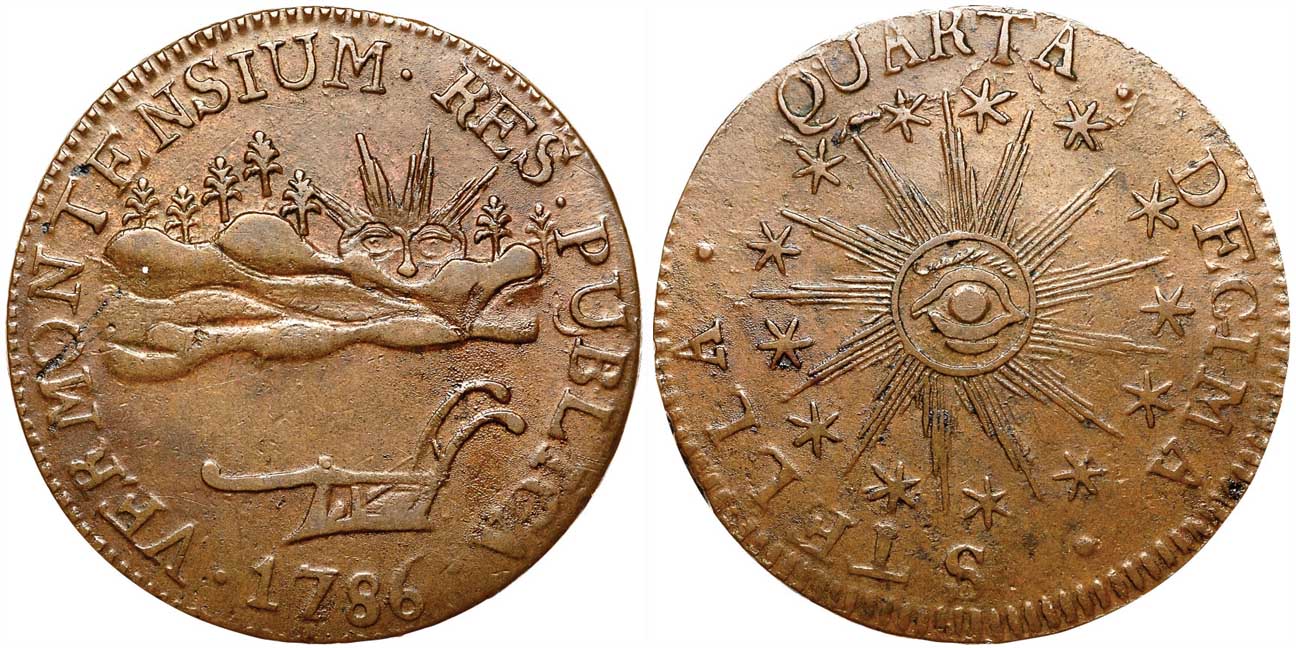
I also liked lot #30026, a VERMONTENSUM Ryder-7 graded higher by NGC at MS62, though this piece had a bit more evident rub on the highpoints and an old and not too obtrusive spot on the obverse. On the other hand, it had lovely color, some mint red in the devices and despite the minor complaints still ranked highly among all landscapes I’ve seen. So I was not expecting it to be inexpensive and it wasn’t, selling for $44,062.50:
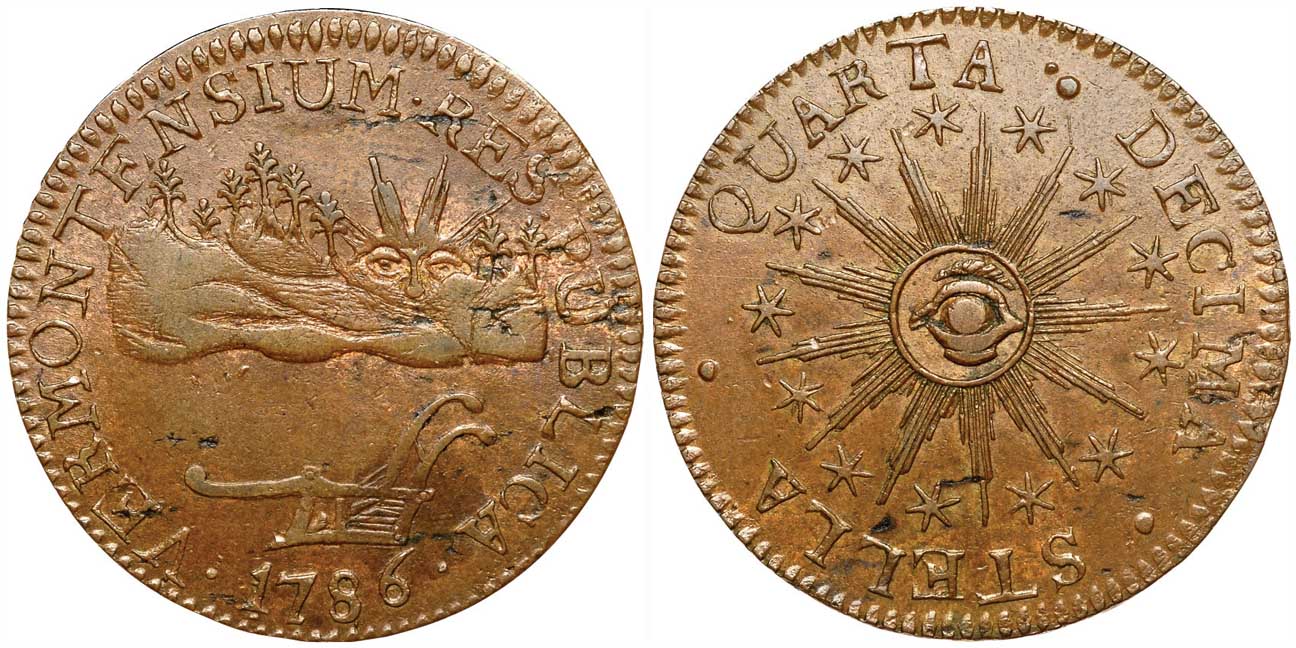
Followed by a run of mostly wholesome but unremarkable Vermont bust types that sold for ‘regular’ prices to, as far as I could tell, Vermont series specialists.
And then began a long run of Connecticut Coppers containing some regular old coins, some condition rarities, some absolute rarities and some things that simply never come to market except when a great old-time collection is sold.
With lot #30064 being the first heady one, the finest known example (apparently by a mile) of the Miller 2.2-D.2 ‘Noble Head’ type in a seemingly conservative NGC XF45+ slab. This is a distinctive issue that I personally believe would be more popular and sought after if you could actually get one that looks decent. Like this one – which explains why it soared to $52,875, trumping your author’s bid in the process:
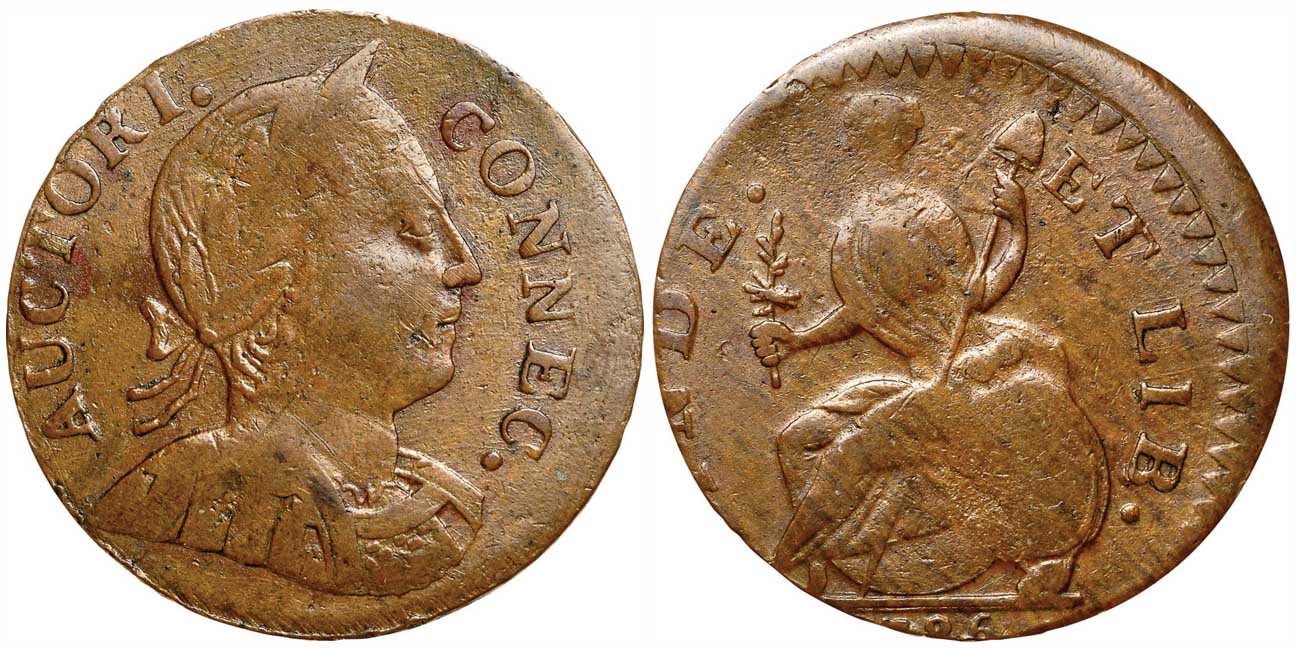
And then lot #30071, a sharp example of 1786 Miller 5.4-G in an NGC AU58 holder, caught my eye, if only because it displayed odd, unoriginal color of the sort that doesn’t normally get graded by the services. Perhaps this coin will resurface after a recoloring as a more natural looking brown (unless it disappeared into a collection, which is also possible):
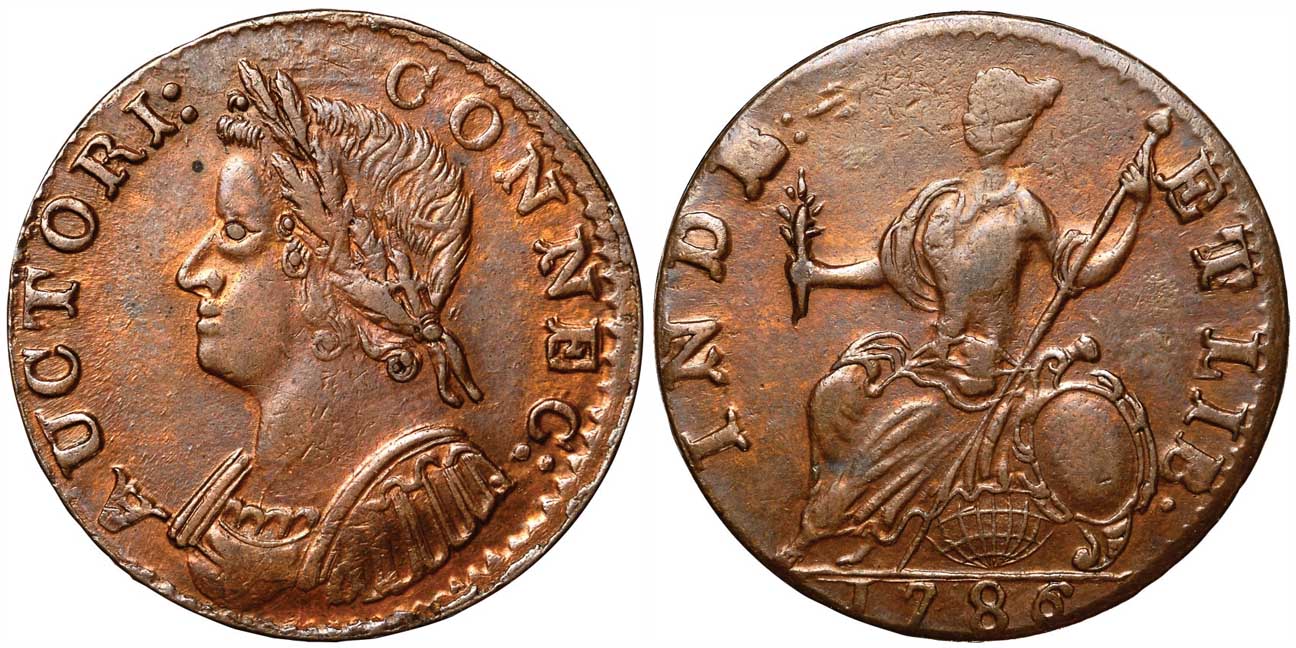
Followed by lot #30074, the very tough 1786 Draped Bust Left Miller 7-K graded NGC AU58 and lauded as the finest known example. And it was a cool coin with fabulous golden brown color that, in this author’s opinion, would not have sold for one penny more than the $38,187.50 it realized even if it did not have that dark spot on the reverse:
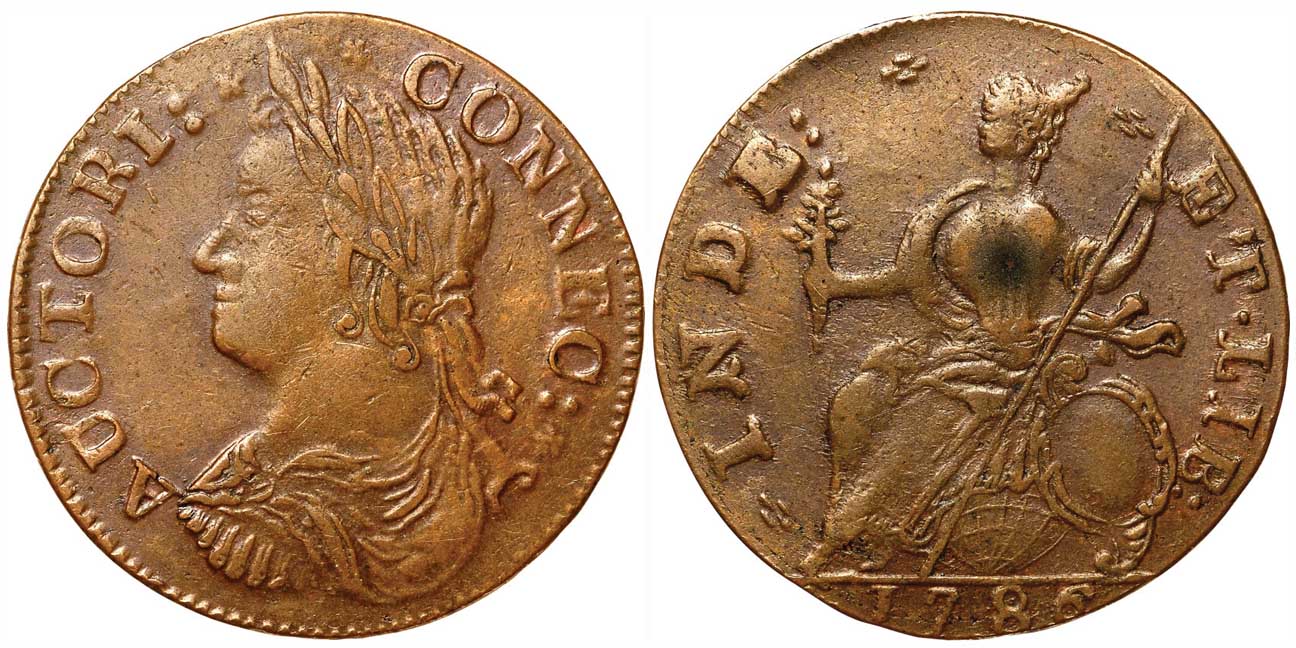
But the star of the CT show was undoubtedly lot #30080, the legendary 1786 Miller 1.4-WW graded F12 by NGC, one of just 2 known examples of this the only issue in the loooong CT series with the reverse figure facing right. And while this one was not exactly beautiful [insert understatement emoticon here], it did represent the first time one of these has been available in, oh, a generation and a half, so if you wanted one you needed to buy it RIGHT NOW. Which a well-known dealer did for $164,500, evidently on behalf of a very, very serious collector:
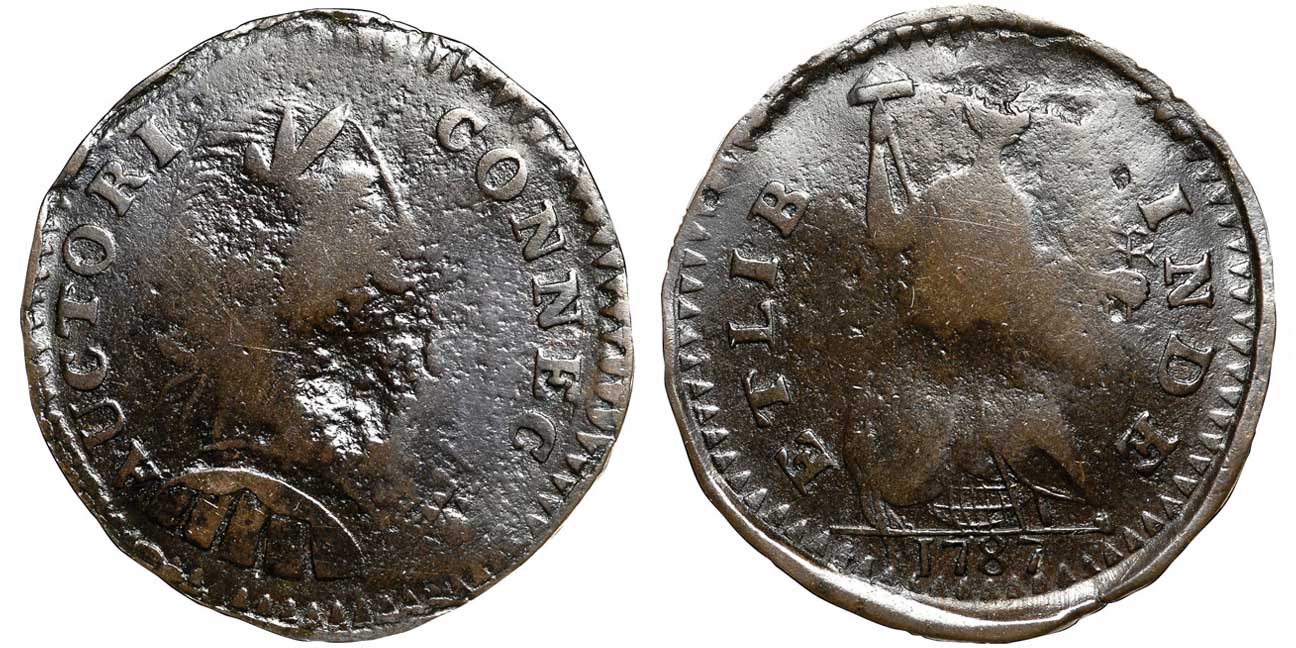
And while I can academically understand the demand for extremely rare issues like that, my own personal tastes gravitate toward coins of a more aesthetic bent, like lot #3012, the 1787 Connecticut Draped Bust Left Miller 33.39-s.1 graded MS65 by NGC and representing one of the finest CT type coins I’ve ever had the opportunity to buy. And so I did at well less than my max bid at $35,250:
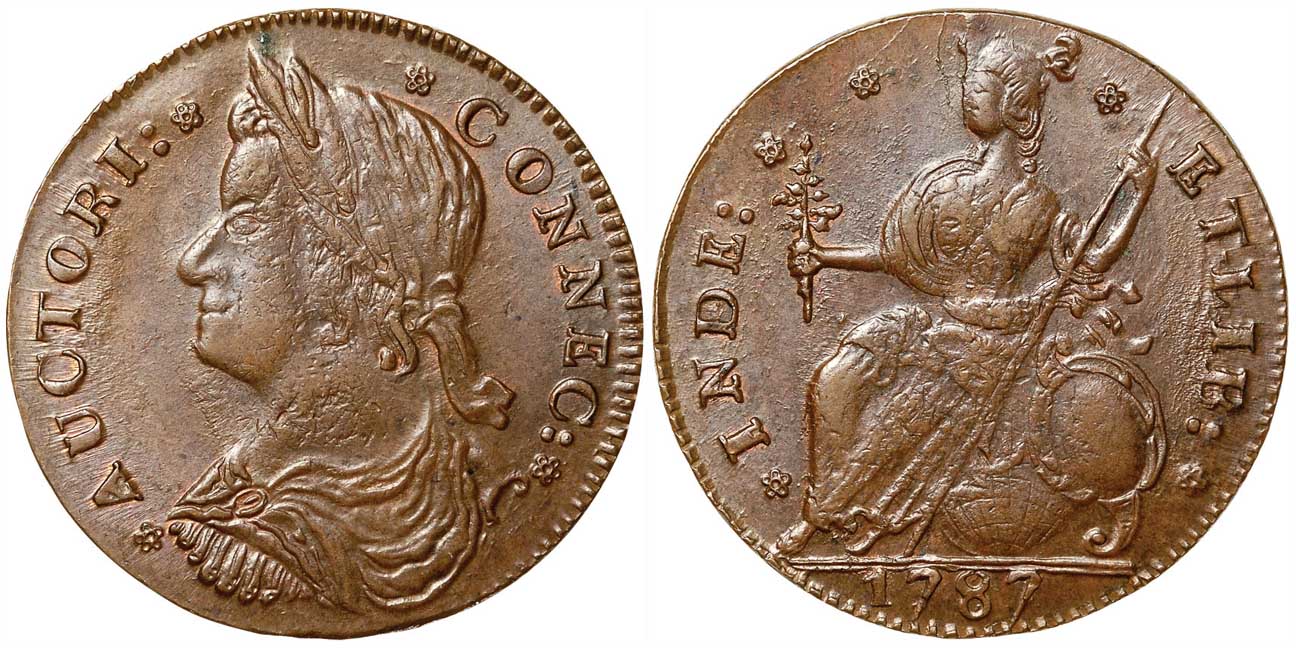
With the CT series ending with lot #30170 a dramatic error coin which had to have been made intentionally by a bored but very creative minter, looked totally groovy, and sold for what I thought was another very reasonable price at $25,850:
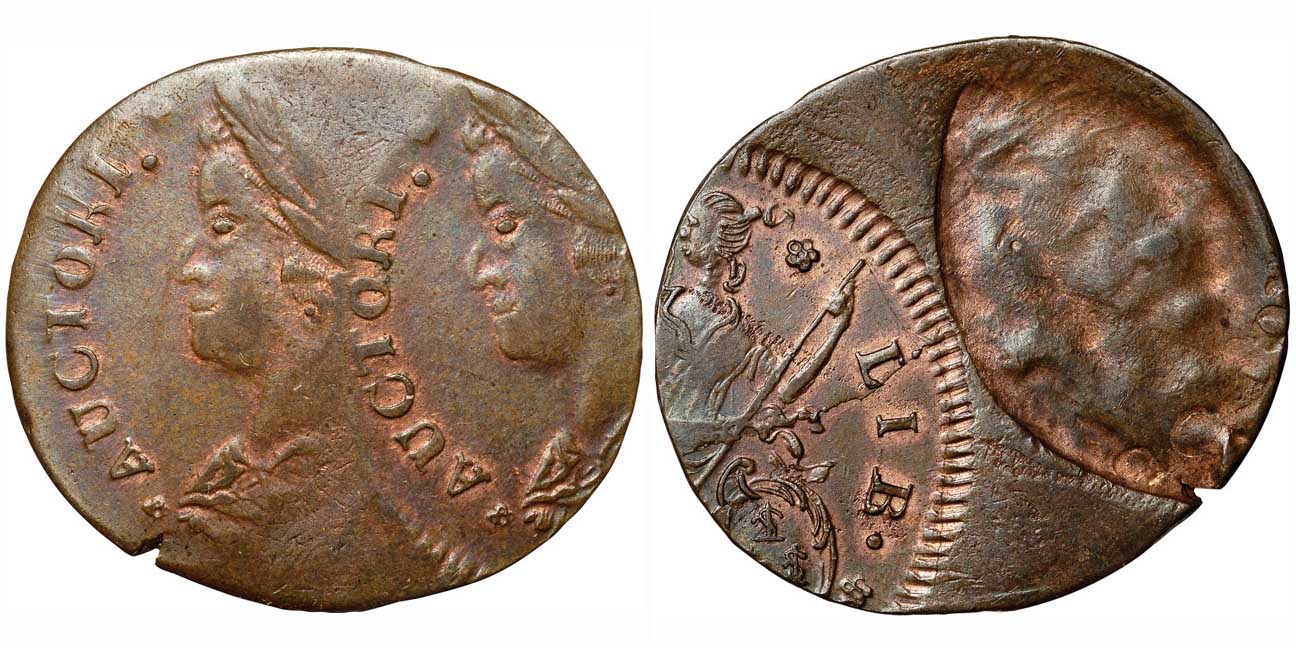
And then we were on to the New Jersey Coppers, where we encountered a series of lots that repeatedly surprised your not–that-easily-surprised author.
Starting with #30173, a 1787 Maris 6-D graded (accurately, in my opinion) as AU58 by NGC, but which sold for $10,575, which was approximately 3x more than I expected:
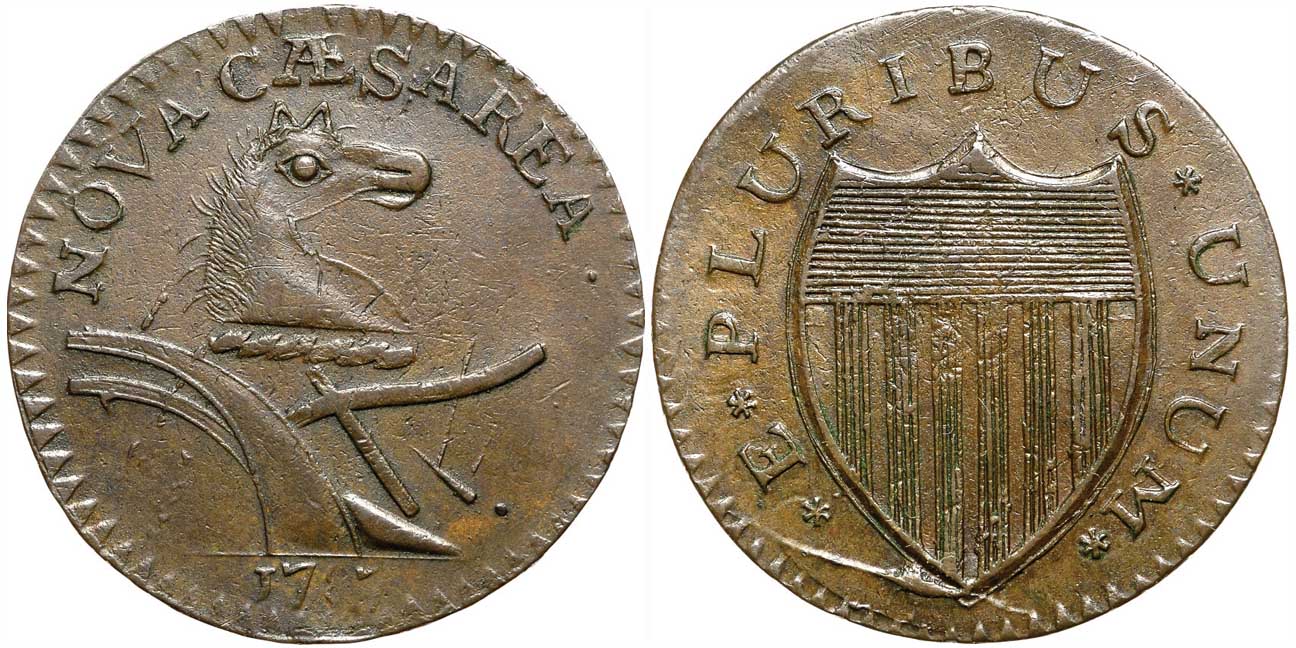
Which I can only assume means that someone (actually 2 someones) saw this as a mint state coin and bid accordingly. I guess?
Then there was lot #30177, a 1786 Maris 14-J which was graded MS65 by NGC but which I personally did not see as a gem:
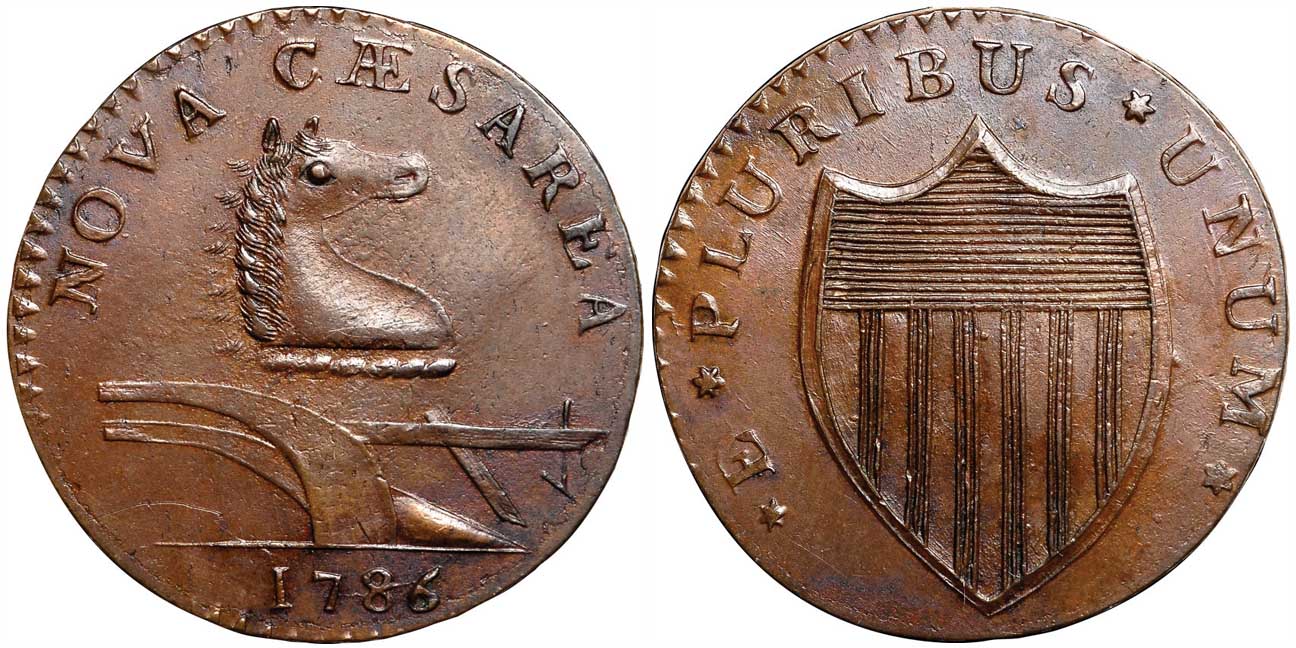
The price realized of ‘only’ $25,850 suggested I was not alone in that view.
And what of lot #30213, the distinctive 1788 Maris 50-f ‘Head Left’ type graded XF45 by NGC? That coin was sharp for the issue, and well made, but I could not get past the bright green verdigris on the reverse:
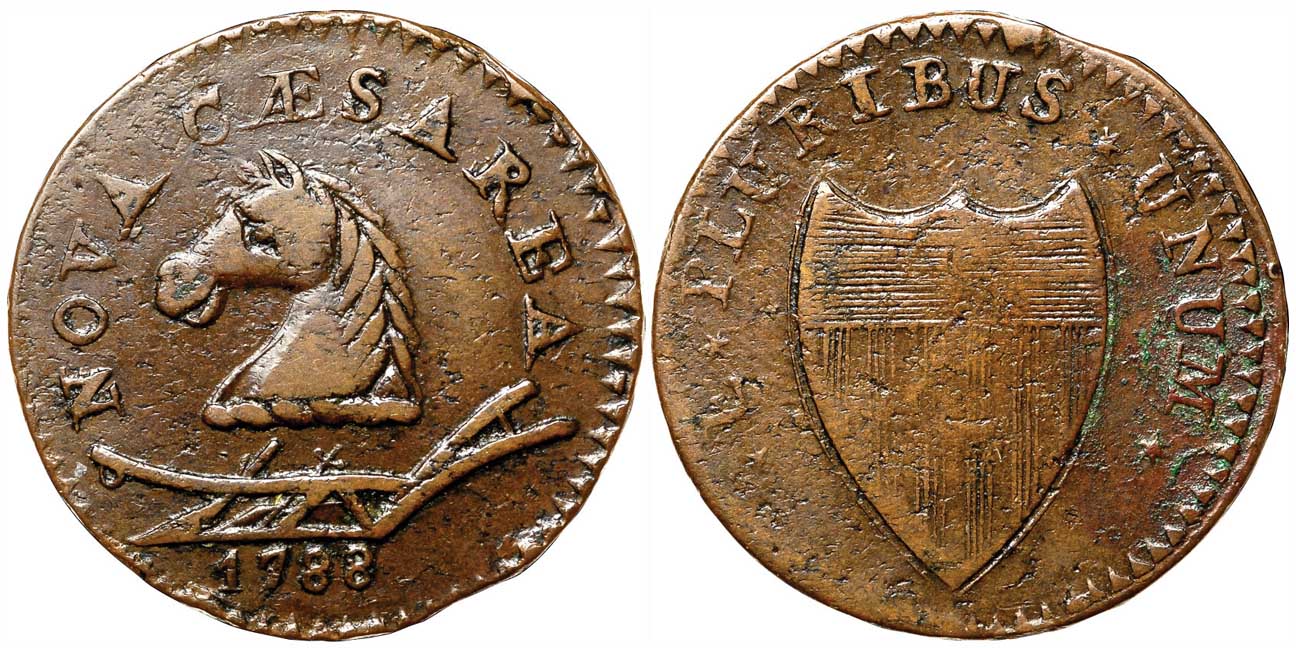
Didn’t seem to matter though, as it catapulted to a $21,150 price which was a multiple and a half of my expectation.
But the most anticipated coin in the NJ series would be the last one, lot #30233, the 1788 Maris 77-dd ‘Running Fox’ graded MS65 by NGC. And it looked pretty darn good to me and others too, with some rapid fire bids carrying it to $105,750 which was about where I expected it to land:
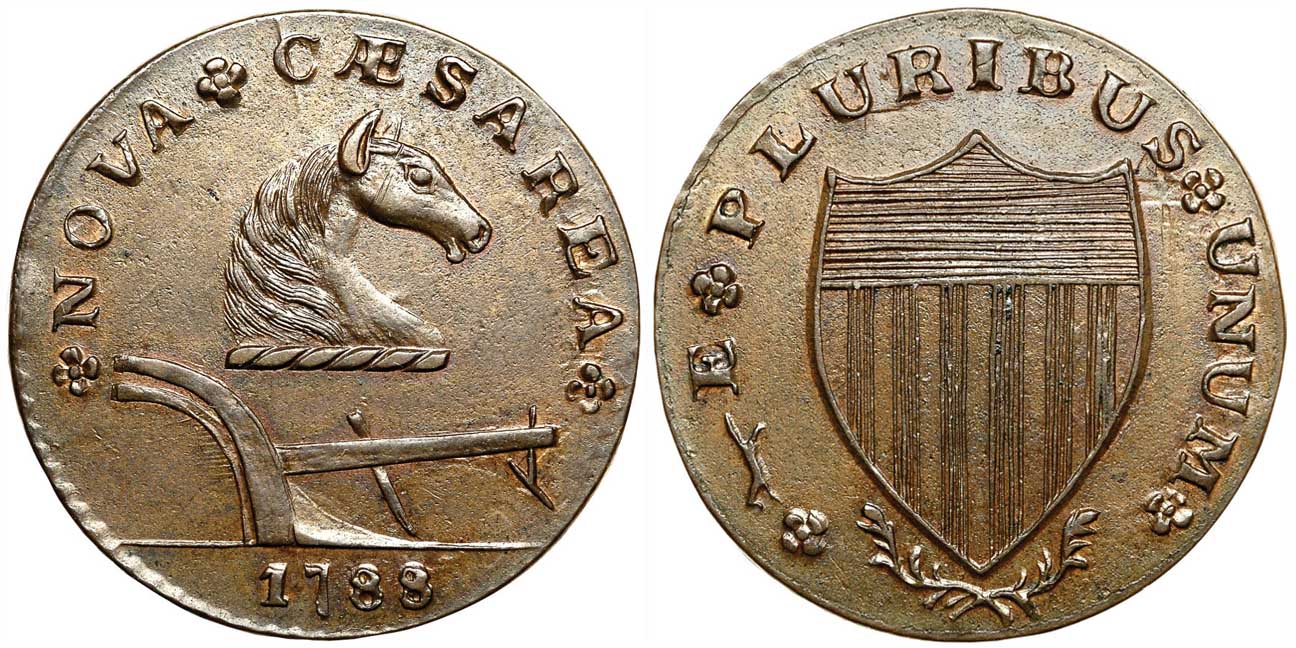
I wanted to pay no more than $100K myself, which means that I did not get it. To be honest, I really did not expect to.
And then came the last group of coins from Session 1, the Massachusetts Coppers, including some really nice and some utterly average coins.
The former included lot #30235 as a lovely, choice, smooth, naturally glossy example of a Ryder 6-D 1787 Half Cent in a totally appropriate MS64 NGC slab. I tried hard to buy this one, but two specialists were on it, outbidding your author at $22,912.50:
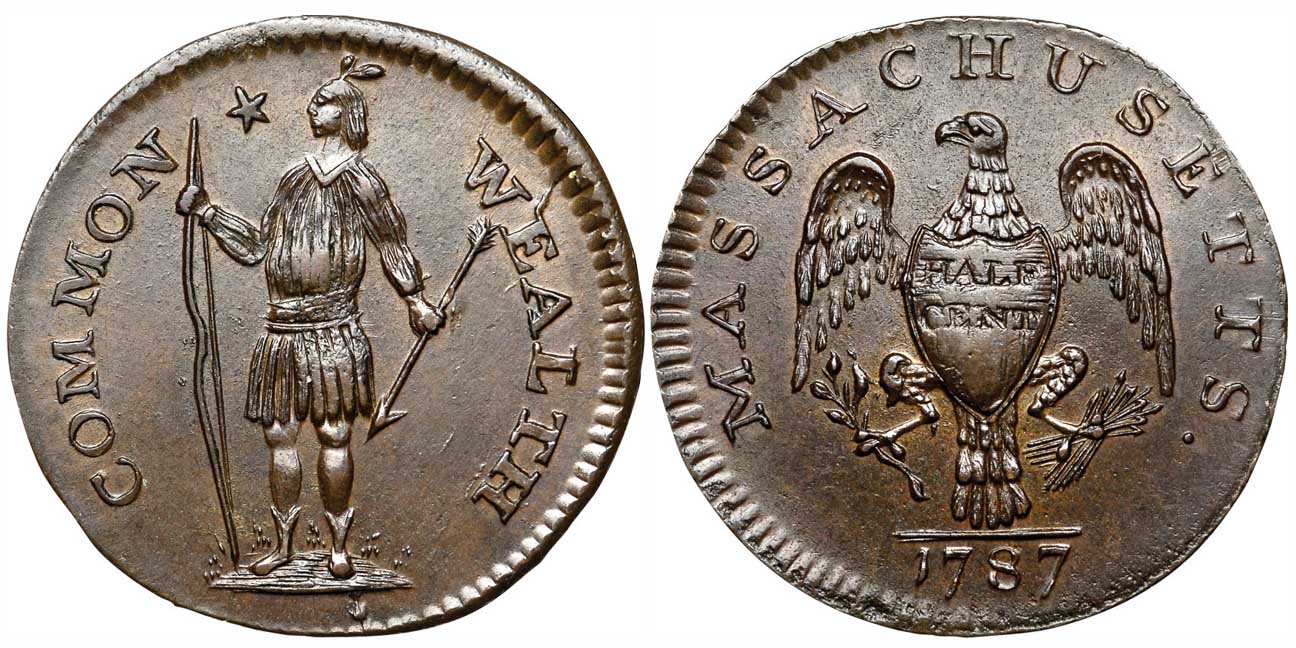
I preferred the look of that coin over lot #30238, a 1788 Half Cent Ryder 1-B also graded MS64 which brought a very soft for the grade $7,050:
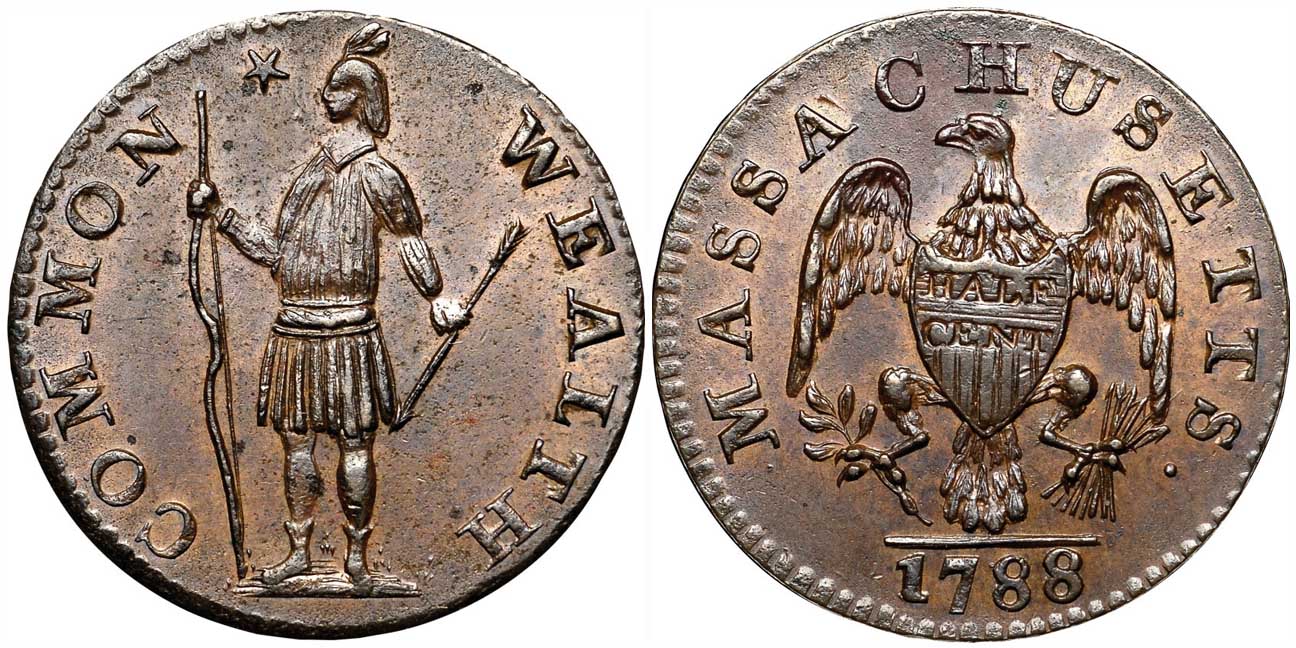
We would be remiss in not mentioning lot #30245, a flawed, rim bruised and pretty beat up Ryder 3-A 1788 Cent in a VF30 holder notable for the fact that it tied with a few other coins as the least expensive in the Newman floor auction at $440.63:
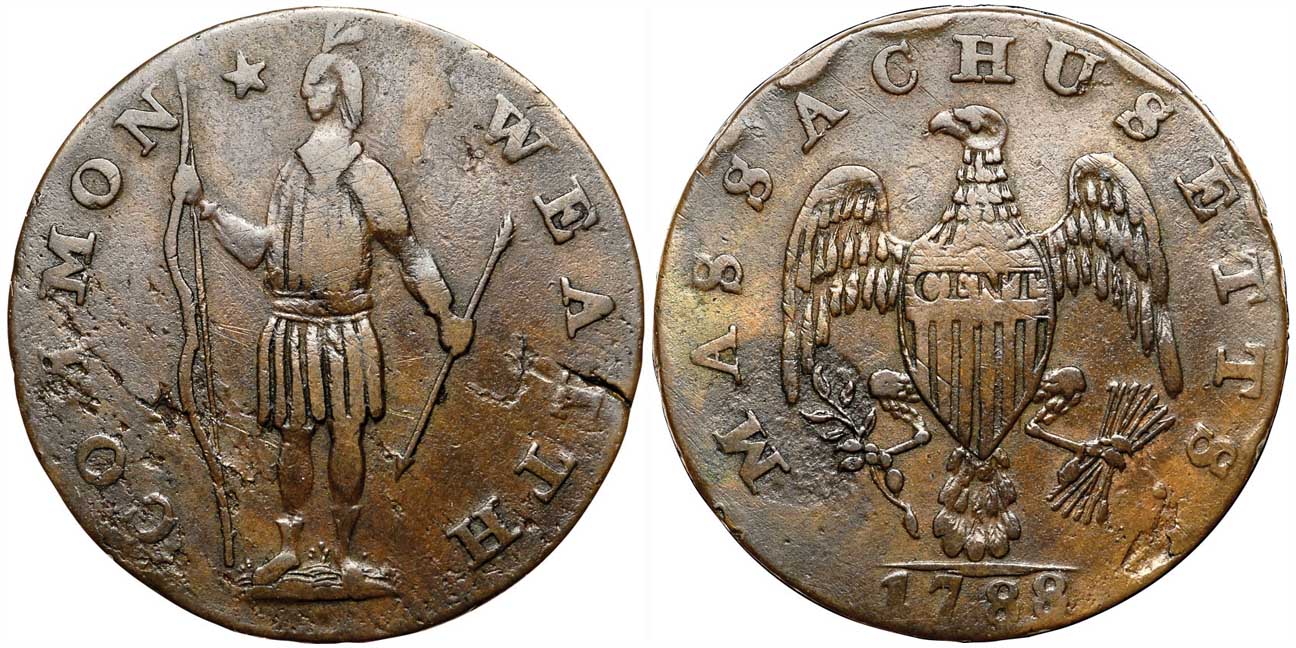
With the series ending with lot #30249, the 1788 Cent Ryder 9-M in another MS64 holder. This a rare issue with superb color but a bunch of unfortunate reverse spots which did not seem to matter much to the bidders who launched it to $32,900:
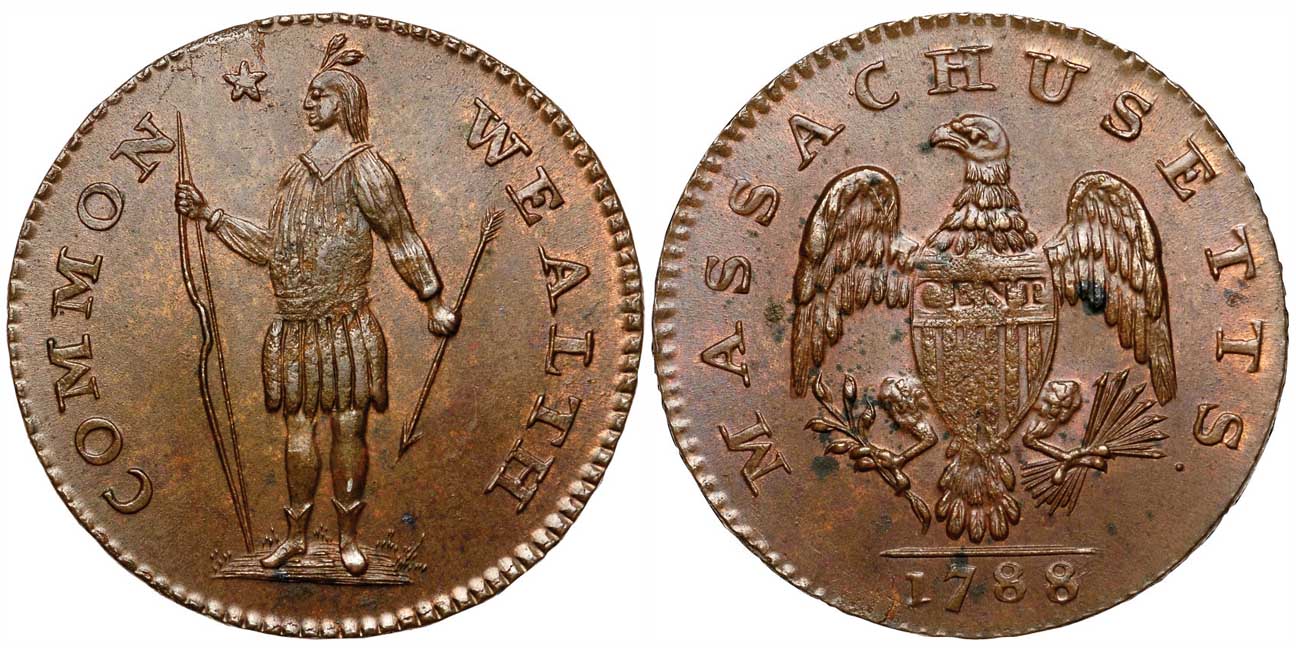
And then Session 2 kicked off with a giant Bermudian bang, as the nicest set of Sommer Islands coin I’ve ever seen delighted bidders, culminating with lot #30257, a fantastic Shilling purchased by a gentleman in the row in front of me for $258,500:
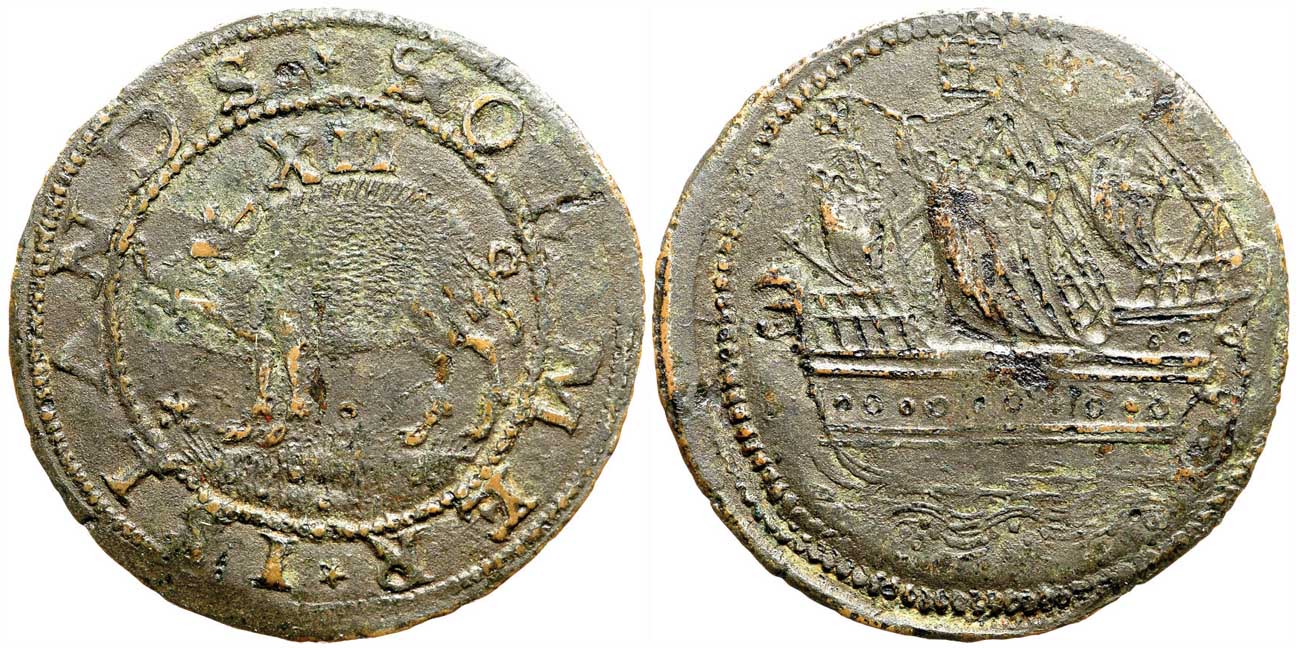
Interestingly, the winner apparently simply perused the catalog during the auction and decided to bid on this item ‘on the fly’, which is an interesting reality at these auctions. I suppose I should be delighted to win anything, since there is no shortage of competition from knowledgeable dealers and serious collectors, but also from people who just sort of wing it. Which means that it is important for me to figure out how much I want to pay and then stay disciplined during the auction, since it is very easy to get caught up in the moment and buy something for more than you wanted by outbidding someone who may or may not have arrived at their bid scientifically.
And then we were on to the Massachusetts Silver coins, a group of mixed quality, starting with lot #30258, the lovely, original New England Sixpence in a suitable NGC AU58 slab which realized a lower-than-I-expected $646,250:
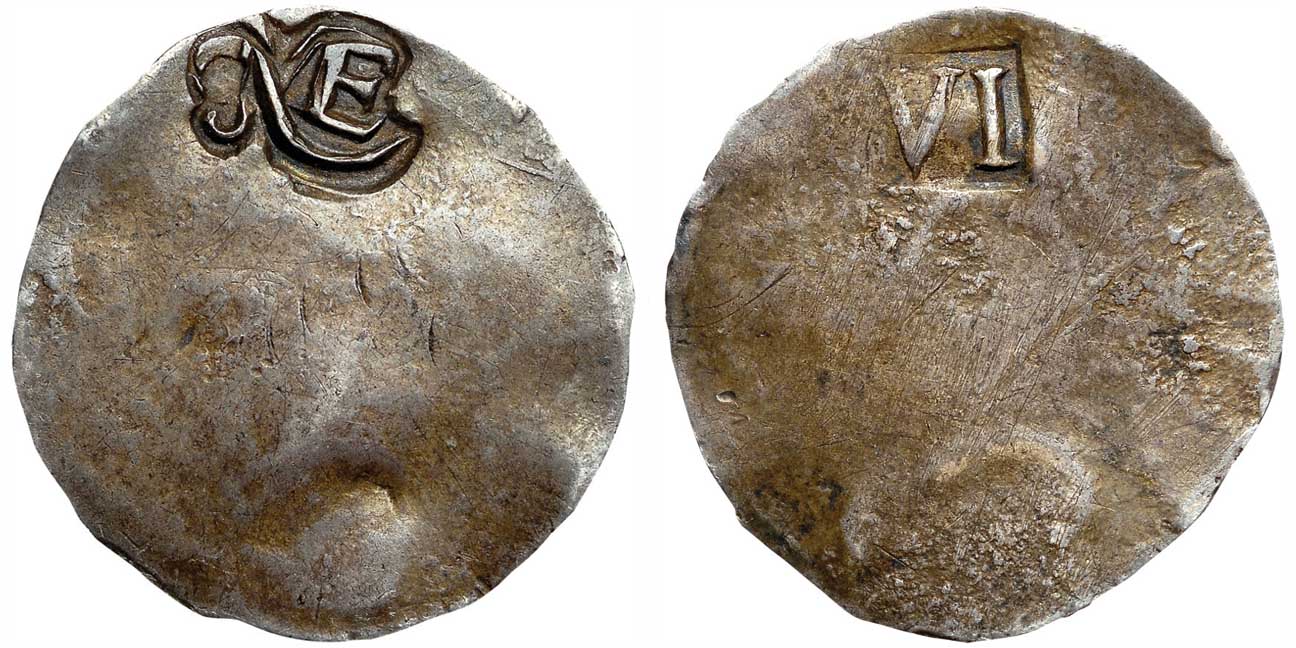
And lot #30266, the extremely round and well struck 1652 Oak Tree Shilling, Noe-4 in an aggressive MS65 slab, which I personally thought looked a lot better from a distance than it did up close, at $105,750:
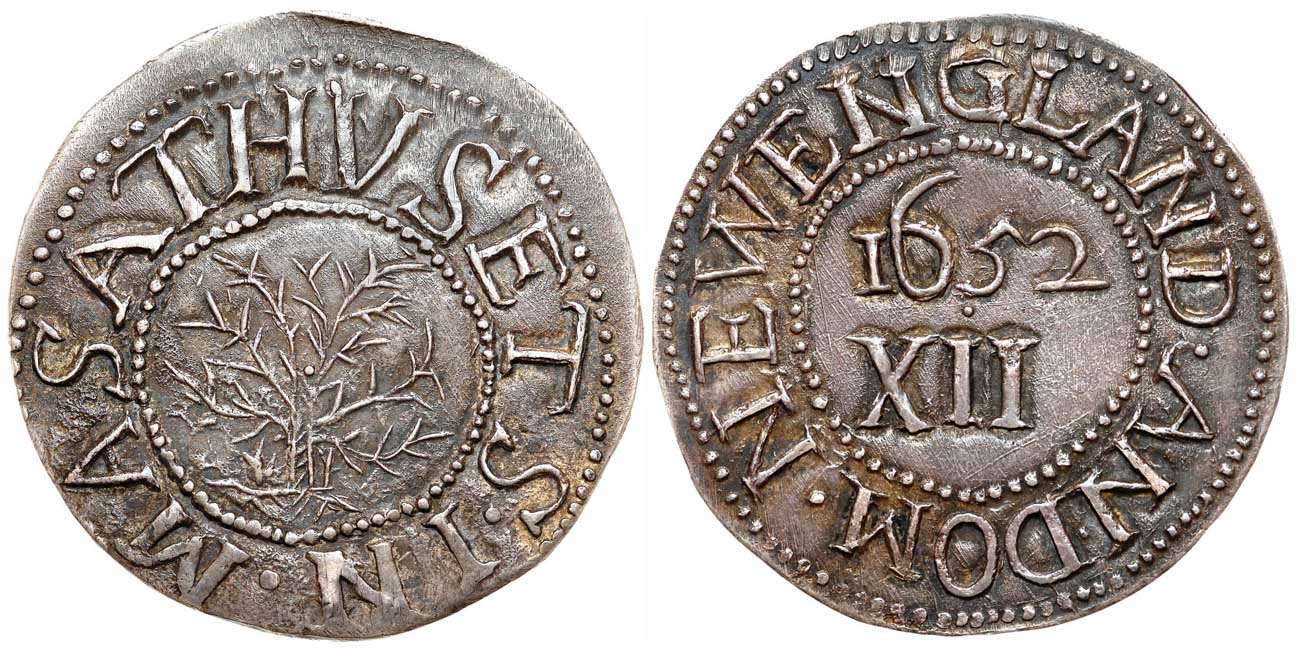
But while those were aesthetic and well made pieces, lot #30267, the rare Noe-6 Oak Tree Shilling graded XF45 was considerably less so, bringing a weak for the grade and issue $11,162.50:
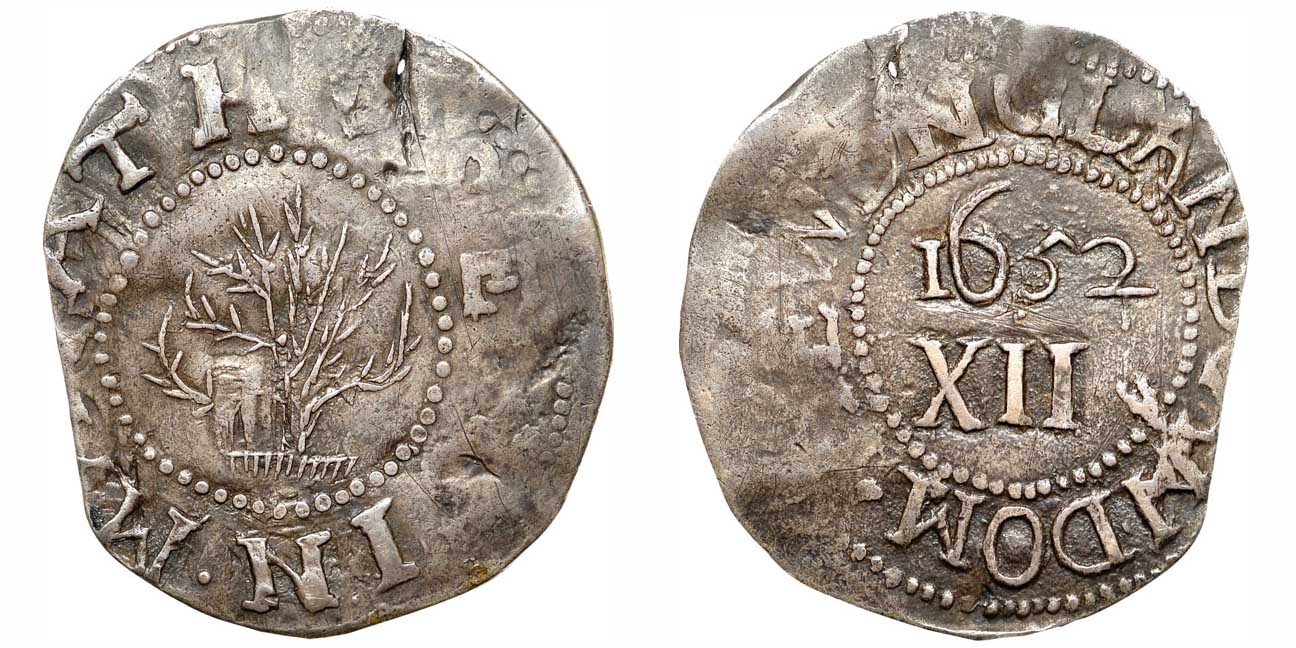
And what to make of lot #30269? That was a sharp and attractive Noe-9 Oak Tree Shilling with a severe crease from having been bent and straightened, but still graded XF45 by NGC at $9,400:
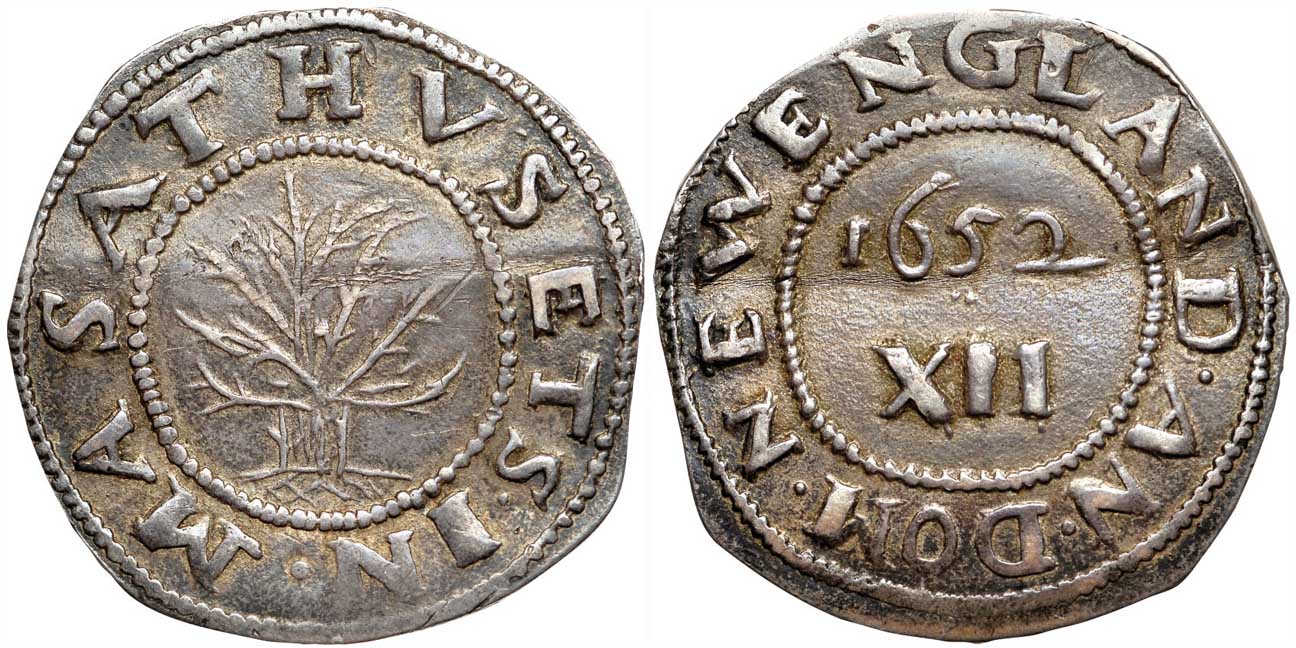
Without the crease, I think that sells for about 2x that price, which is why looking up auction prices realized without pictures can be highly misleading.
Which contrasted dramatically with lot #30272, a superb Pine Tree Threepence graded MS63 by NGC, but looking more like MS64 or better to my eye. I tried to buy it too, but was nipped by a half increment at $49,937.50:
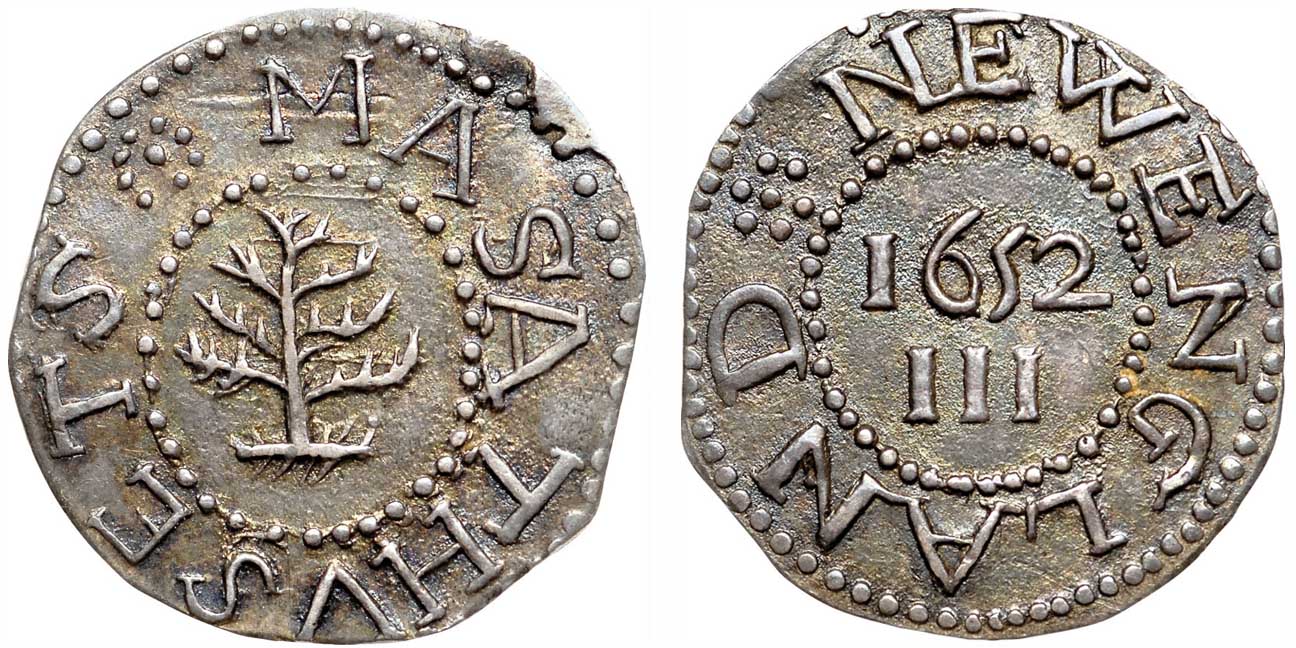
And then we were on to the St. Pats series, where one particular coin caught my eye. That would be lot #30310, a Vlack 4-E Halfpenny graded VF30 by NGC and notable for its lovely color, choice surfaces and for the fact that this coin was sold to Mr. Newman by CRO:
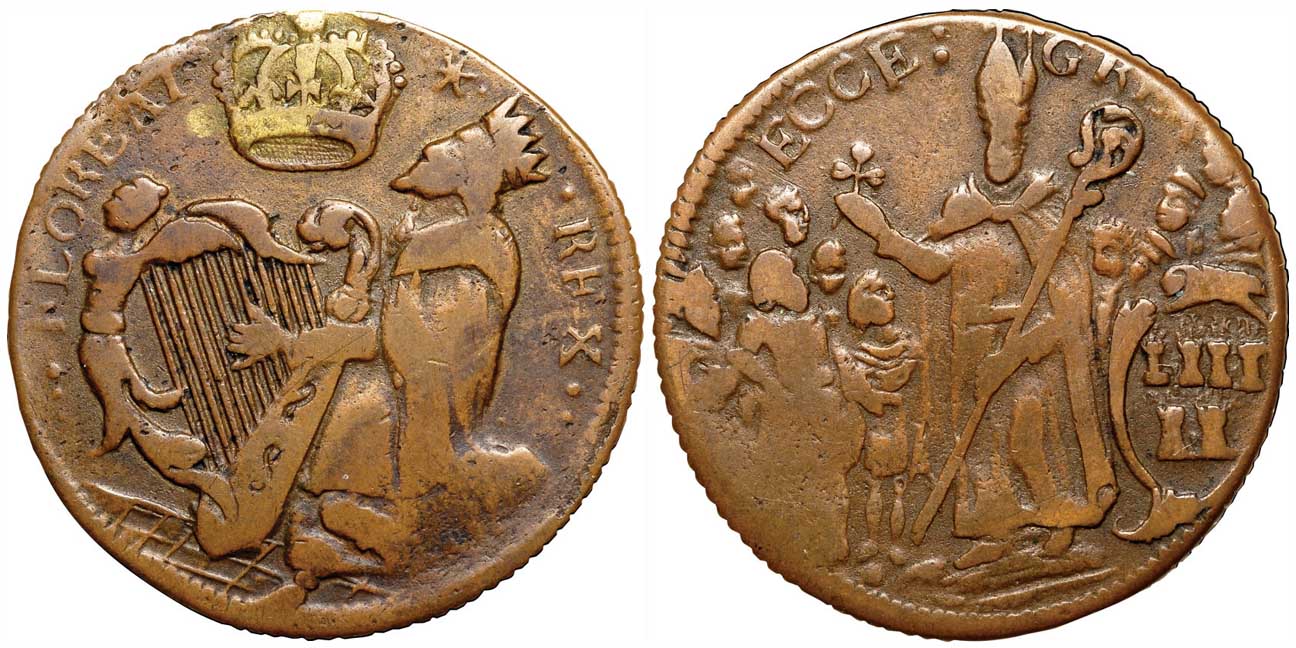
Q: Huh? I thought these coins were collected 80 years ago and off the market ever since?
A: Not all of them, as evidenced by this slab photo taken back when we last owned it:
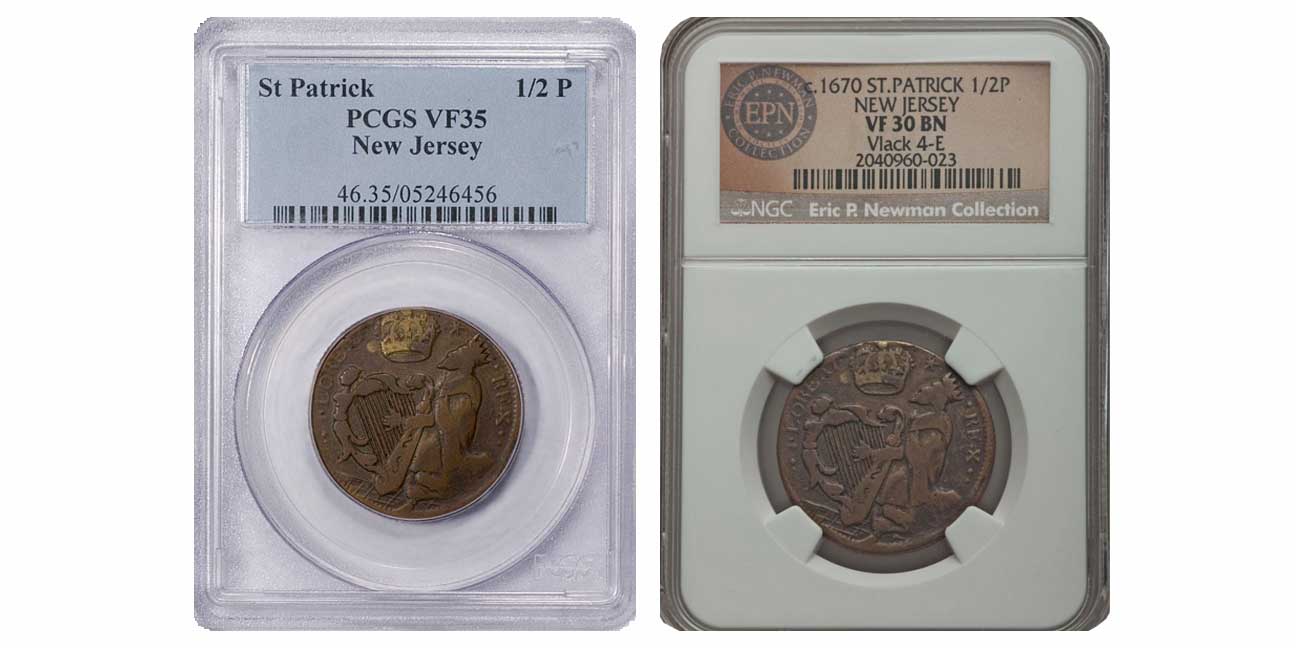
Of course I planned to buy that coin back, and did so at $4,700.
I next turned my attention to the American Plantation Tokens, one of the more anticipated series in this auction (for me, anyway) since Mr. Newman literally wrote the book on these coins and personally developed the attribution system to identify the varieties. And so I was extremely disappointed with the overall quality of the offering which I would describe as extreeeemely average.
Such as lot #30316, the N.3-C Sidewise 4 variety in an XF Details slab which realized $1,292.50:
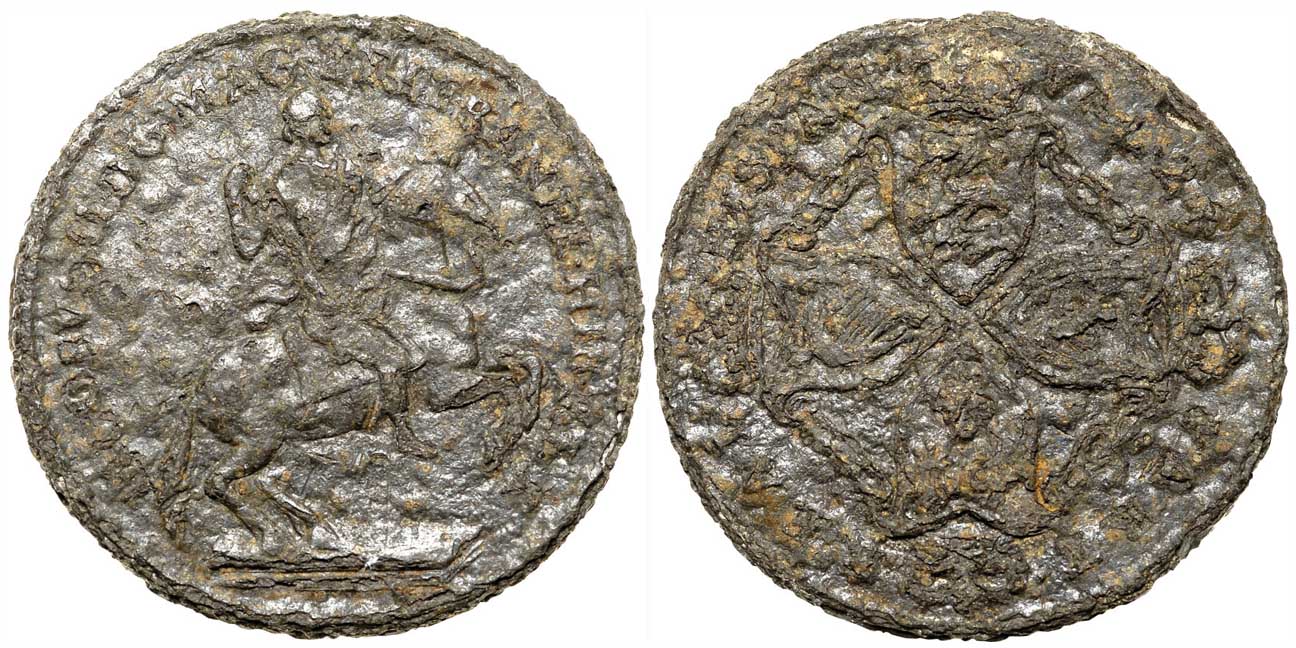
I’m guessing these were the Newman Collection duplicates, and that some nicer ones were kept for the museum. Maybe.
Anyway, next were the Elephant Tokens and including one variety I had never seen before, lot #30325, a unique piece struck on a thick brass planchet and bearing the cool “Reverend Henry Christmas” pedigree. This one was graded MS61 by NGC despite the mother of all planchet cracks and brought $19,975:
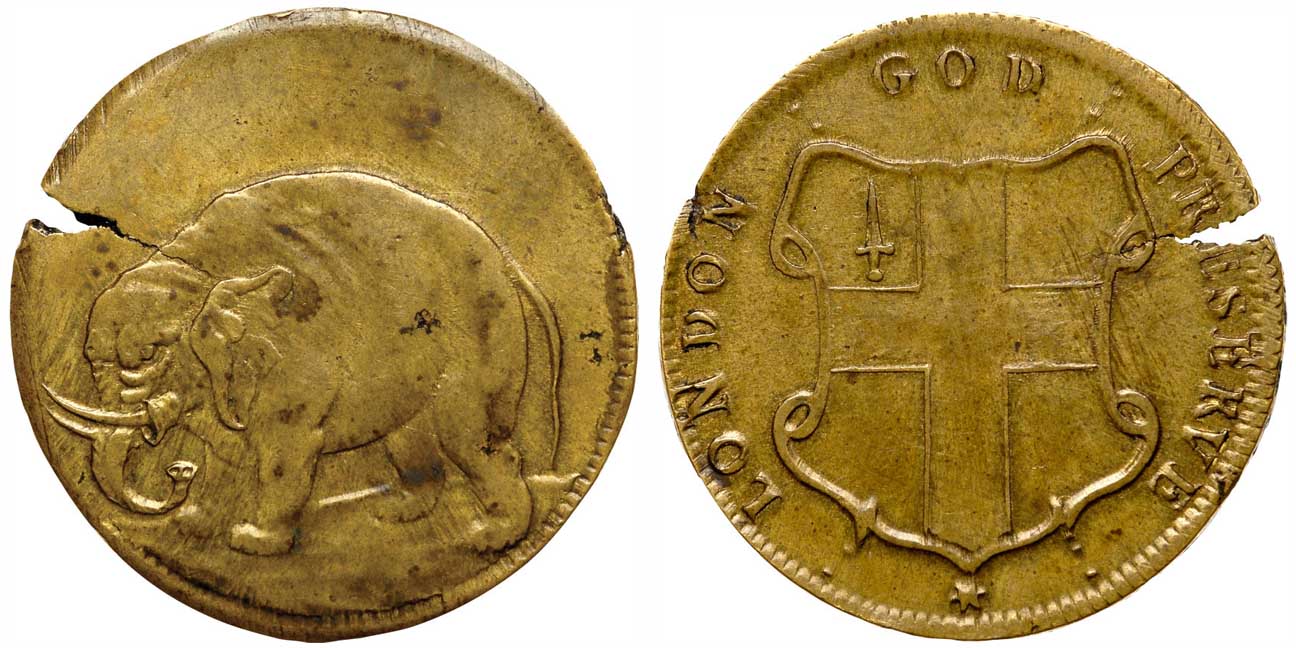
And then we were on to the Rosa Americana and Hibernia coins, containing a large group of mostly very average pieces, though there was lot #30349, an example of the rare 1722 Rocks Halfpenny in reasonable NGC VF25 holder. I saw that as an unremarkable example, darker and more off-center than most, and so I was surprised to see it bring what I thought was a very robust $16,450:
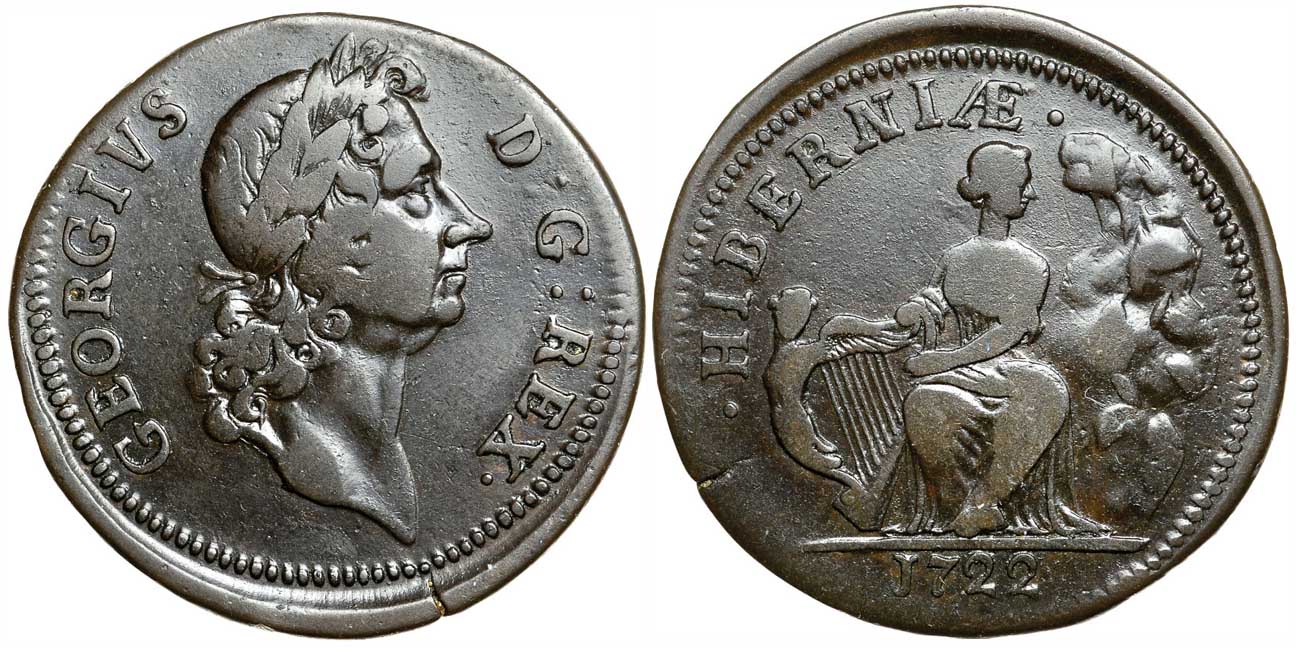
Followed by perhaps the most anticipated series of the auction, the Higleys, a 5-coin group of widely varying quality starting with lot #30365, the highest grade, best detailed example I’ve ever seen or know about. It was not perfect, with some old lacquer, stray scratches and bits of verdigris on it, but all of those were inconsequential for the issue as it brought about what I expected at $470,000:
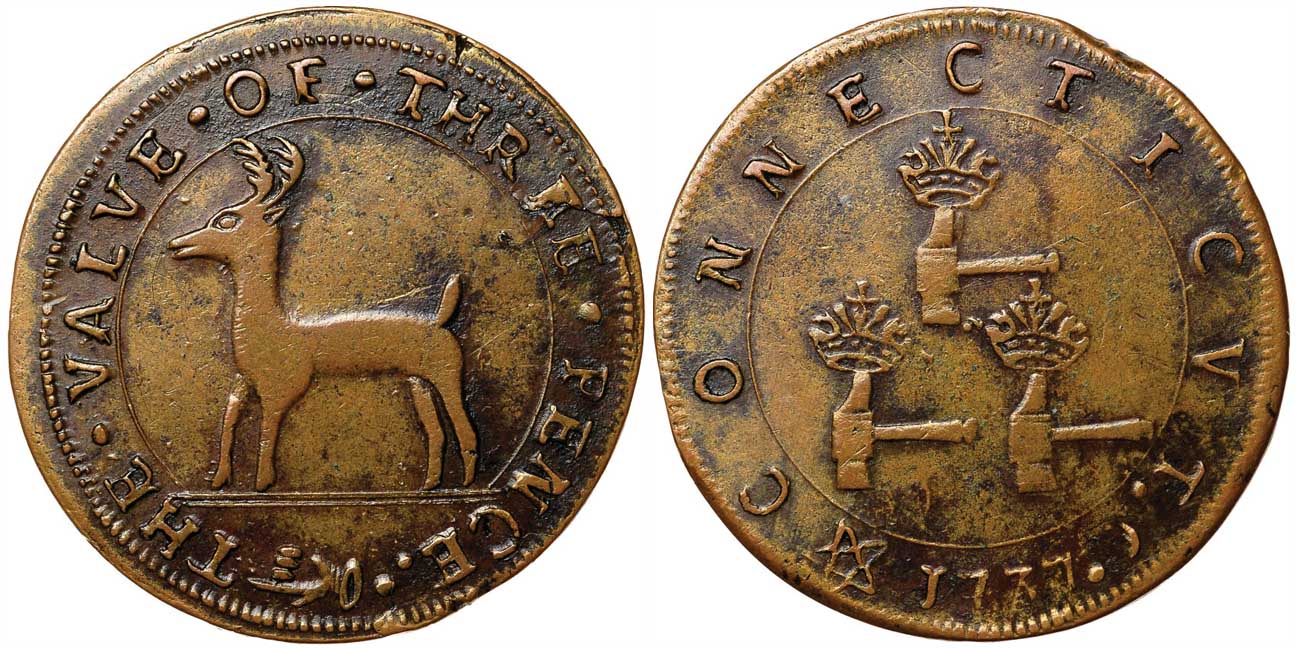
Followed a few minutes later by lot #30368, a lower grade but IMO more aesthetic NGC VF30 example. And while this too had a few issues, including evidence of an old wipe and probably an old recoloring, it was inarguably desirable and I knew it wouldn’t be cheap. I tried very hard to buy it too, but it got away at $199,750:
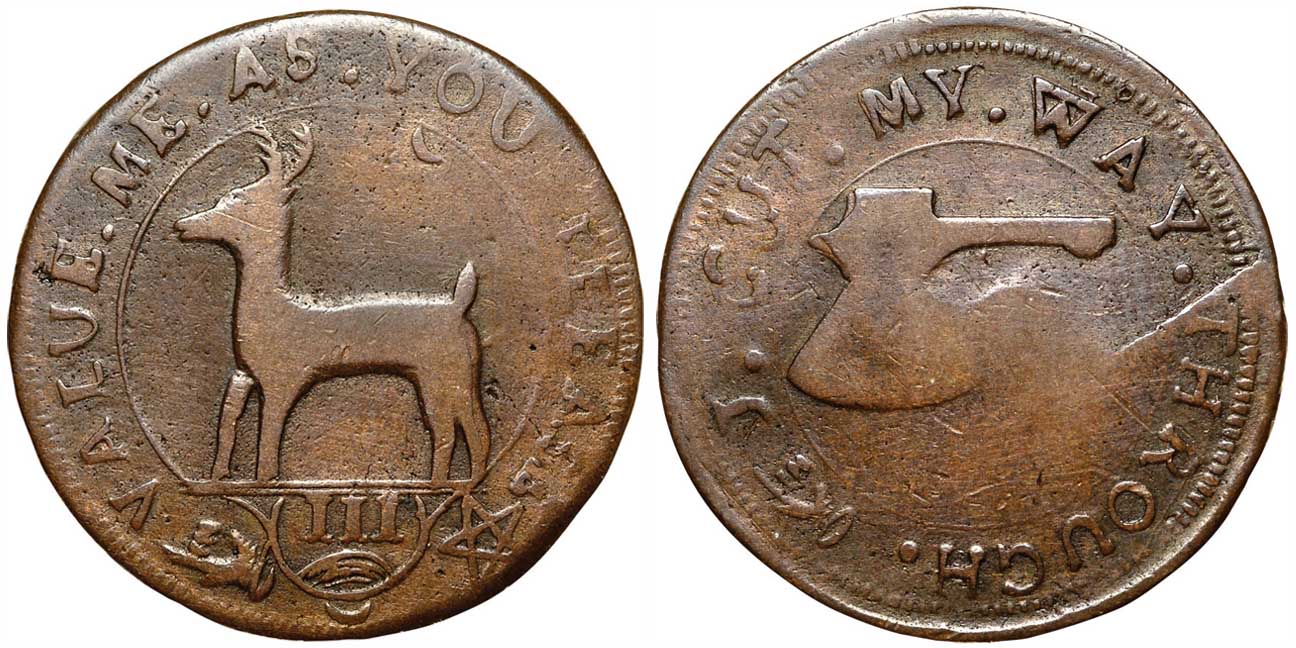
Interestingly (or depressingly, depending on your perspective), my max on this coin was 200K all-in, and I could have been the buyer had I landed on the winning bid first. But I didn’t. Of course the winner may have then bid again and trumped me anyway, so I choose not to dwell on the might have beens. If there is a take away here it is this: If you want to make sure to “own” your max bid, you need to bid in advance and lock it in so someone else doesn’t beat you to it. I chose not to do that for this auction primarily so I could have better control of my overall spending, but that strategy might have cost me this coin.
Anyway, I had a brief moment to recover before the next highly sought after coin, lot #30375, the lovely 1787 Nova Eborac in an NGC MS64+ RB holder. That was graded about right IMO, but wasn’t especially well struck and had a slightly distracting clip, neither of which seemed to have any effect at all on the price as it rocketed to $55,812.50, eclipsing your author’s own sky high bid in the process:
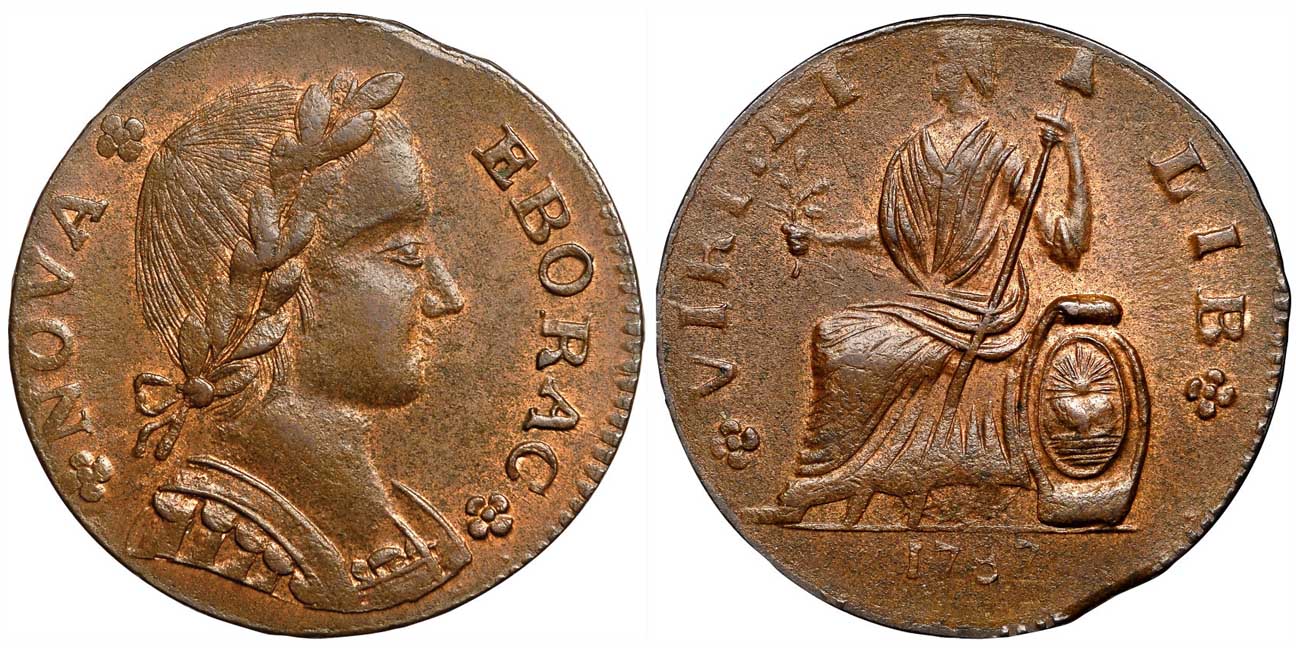
Without the red, I figure that coin would have sold for about $10,000, indicating once again that people really, really like ‘R’ (especially on coins that don’t normally come with it).
And then came lot #30380, the 1787 George Clinton Cent in an ambitious NGC MS63 holder. Regardless of the grade assigned, I believe this was the finest example to come to auction since March of 1973 and so we all knew it was not going to be a bargain. And it wasn’t, bringing $499,375 to a serious collector who has wanted one for a really, really long time:
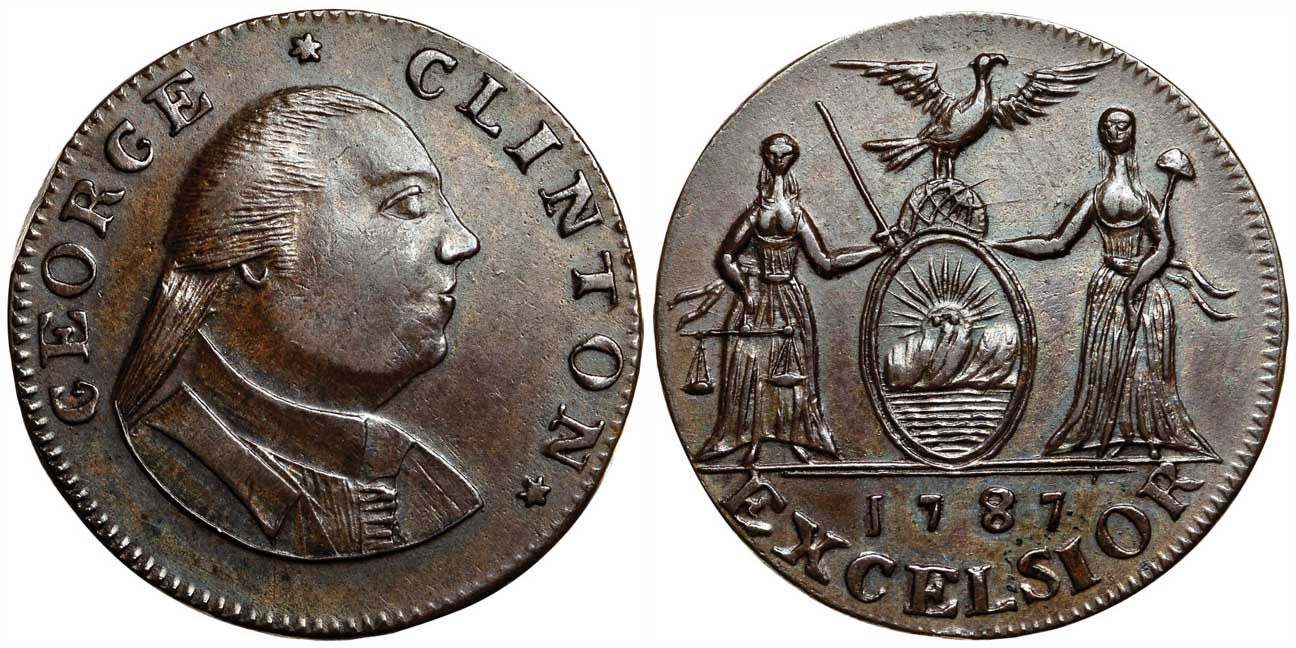
Followed shortly after by lot #30423, the 1776 Continental Dollar in Silver graded MS63 by NGC. I personally thought this coin was more like AU, though I am not surprised to see something like this graded ‘1804 Dollar style’. Regardless of the number, it is the finest of the issue, and I knew I had no chance to be the buyer anyway. Which is unfortunate, since the $1,410,000 it brought (tied for highest price of any coin in the auction) seemed downright cheap to me, relatively speaking, and I personally believe the new owner will make a fortune (or possibly a fortune and a half) when he eventually sells:
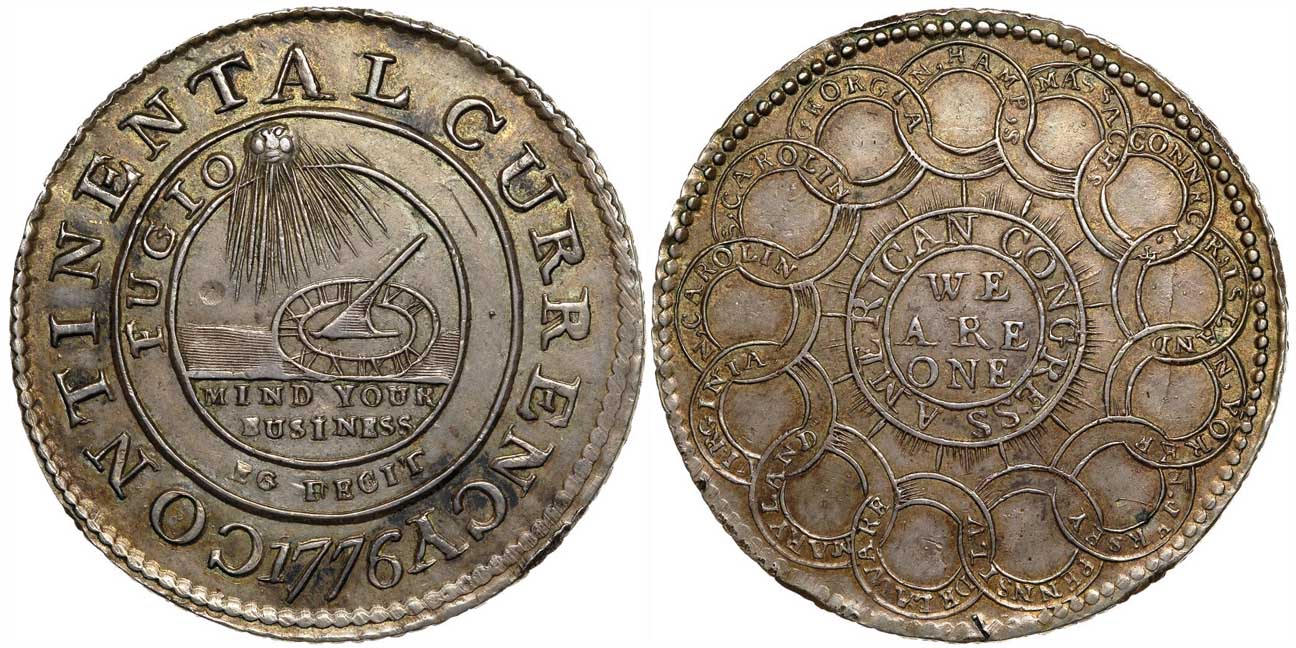
And from that lofty perch we will end with internet session lot #3056, an extremely well-loved 1723 Hibernia Farthing in an NGC G4 slab:
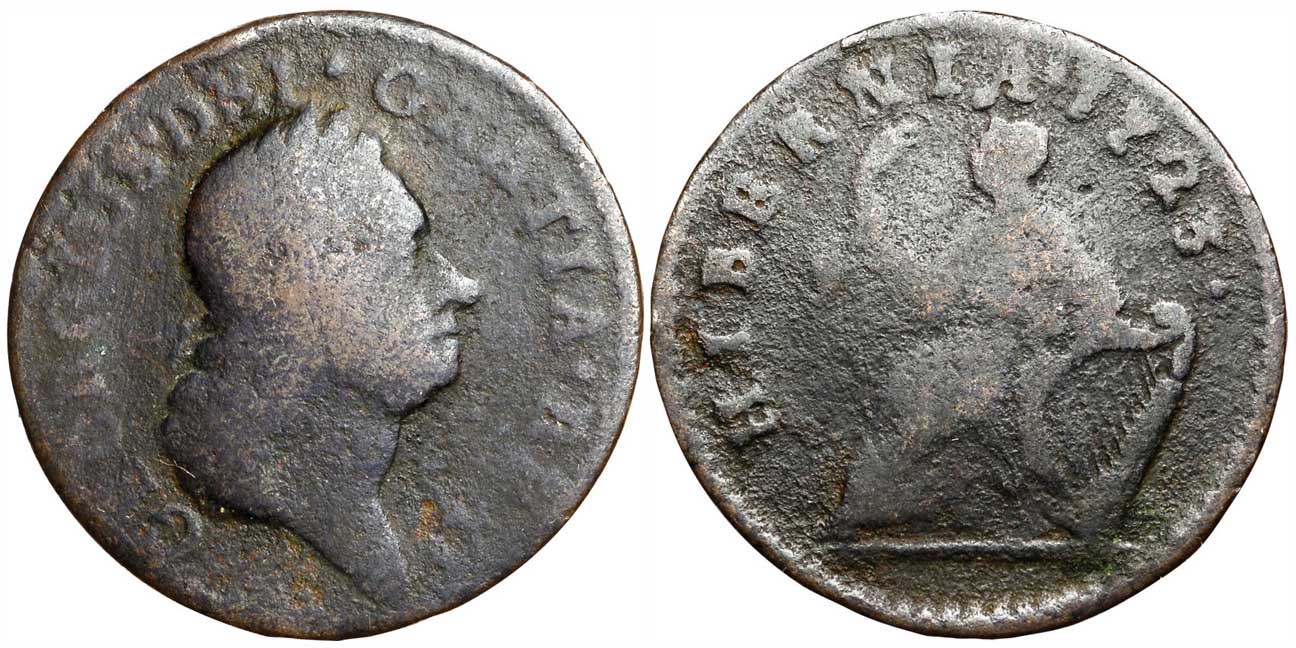
And why are we discussing this item? Because it was the lowest priced coin in the entire auction at $64 and thus the Newman sale equivalent of buying a Mona Lisa coffee mug in the gift shop when you visit the Louvre:
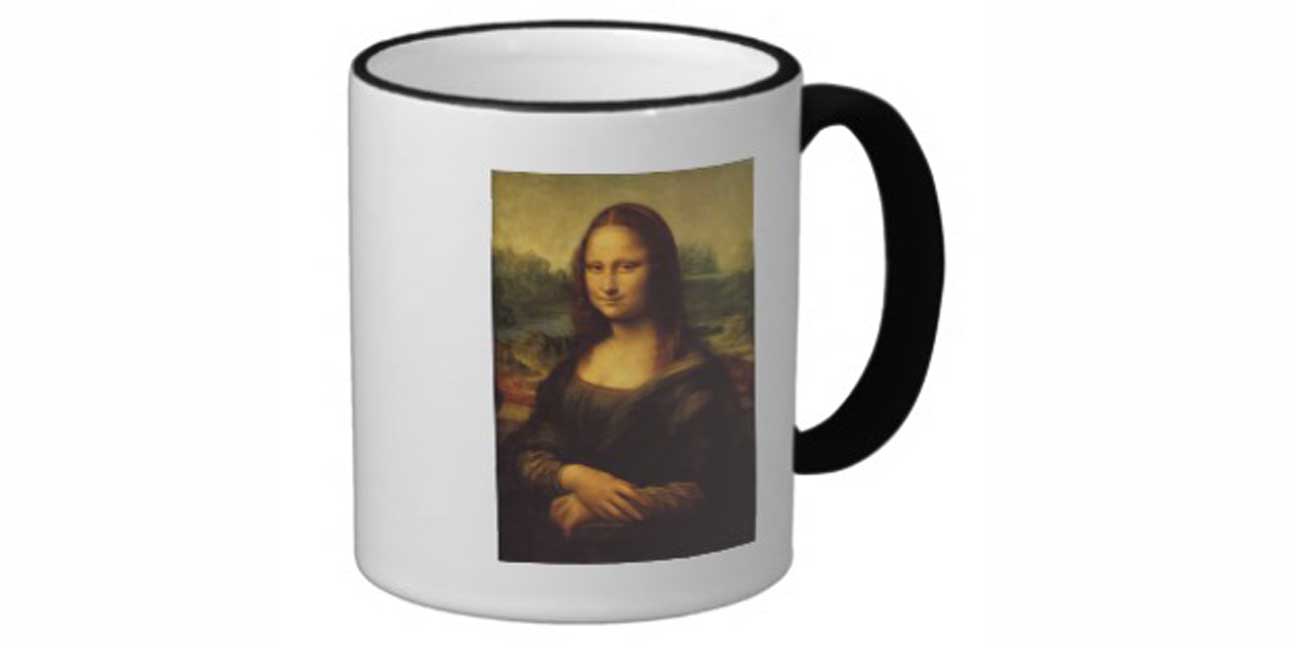
So how did CRO do? We were very pleased to buy 40 coins, some at our top bid, others for well less than we expected to pay.
We were also outbid by one increment on a couple of pieces which is always disappointing and makes you wonder if you should have kept going. In general, I think it’s better to be blown away and have no chance to win, which also happened in this session a few times. And we were SHOCKED not to buy a few items, including the aforementioned Sommer Island Shilling and Nova Eborac that we figured would be ours. But overall we can’t complain with the results and found the preparation time paid off nicely.
And now that we bought them, we need to figure out what to do with them. So we will be sorting things out here before eventually bringing these coins to market over the next few weeks, so you might want to keep and eye out for that.

